Tokyo 2020 is just around the corner, so what better time to bring you 60+ stats about the Olympic and Paralympic Games? We’ll cover all of the important Olympic-related information. The ancient history of the Olympics? Check. The people, places, and nations that make the Olympics so fantastic? Yep.
What about Tokyo 2020? Progression at the Olympics and Paralympics? Scandals? Hacks? Health and Safety? Check, check, check.
We’ve done loads of research and put everything in one place so you don’t have to. On your marks, get set, and get ready to have your mind blown. Here are 60+ Olympic and Paralympic statistics.

The History of the Olympic Games
The Olympic Games are rooted in thousands of years of ancient history.
The Olympics originated in ancient Greece, and the games have given rise to several significant events since their restoration as the “modern Olympics” in the late 19th century.
Let’s take a closer look at the history of the Olympic Games.

General Statistics
We’ll start things off with a few general statistics; the “how,” “what,” and “where” of the Summer and Winter Olympic Games.
Numbers of Olympic Events Held
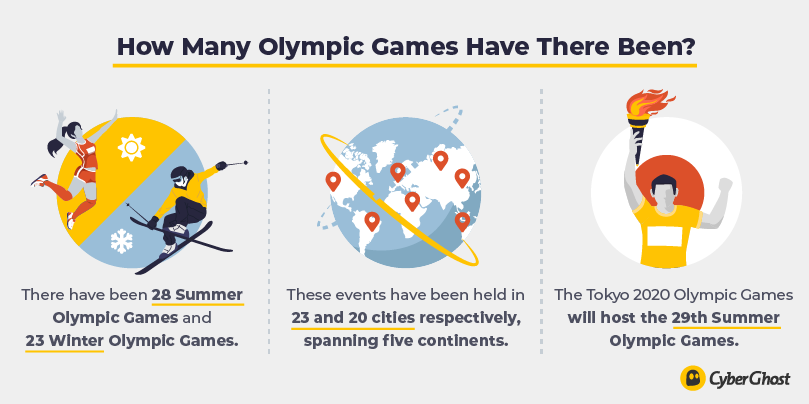
There have been nearly 30 Summer Olympic Games since the competition’s revival at Athens 1896. The Winter Olympics has registered more than 20 events following its inception at Chamonix 1926.
The Paralympics, launched in Rome in 1960, has held 15 events and the Winter Paralympics has occurred on 12 occasions.
PyeongChang in South Korea was the 20th city to hold the Winter Olympics and Rio de Janeiro, Brazil, became the 23rd city to host the Summer Olympics in 2016.
There have been three canceled Olympic events in total. The 1916 Berlin Games were canceled during World War I. The 1940 Tokyo Olympics was canceled as Japan prepared to enter World War II, and London’s 1944 event was also abandoned because of the Second World War.
Countries That Have Hosted The Olympics
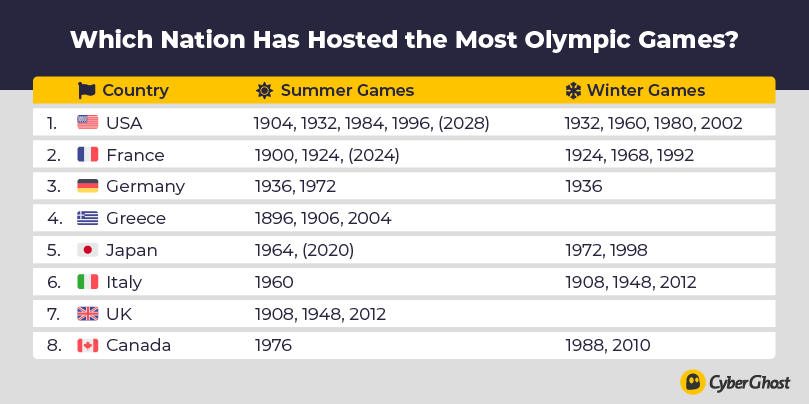
The United States of America has hosted more Olympic events than any other nation, with 8 in total. France has hosted 5 Olympic events, and Germany, Greece, Japan, Italy, UK, and Canada are tied 3rd with 3 Olympic events.
European nations have hosted more Olympic events than any other continent (17 Summer Olympics, 13 Winter Olympics). North America has hosted the second-most Olympic events (7 Summer Olympics, 6 Winter Olympics), while Asia is 3rd on this list with 3 Summer Olympics and 3 Winter Olympics. Oceania has hosted the Summer Olympics 2 times in Australia.
Despite the inclusion of all 5 continents on the Olympic flag, several regions are yet to host an Olympic Games. Cape Town (South Africa) and Cairo (Egypt) have both previously failed in their bid to host the Olympics. In fact, Africa and the Middle East are two regions that have never held an Olympics. Istanbul (Turkey) is another Middle Eastern city desperate to host its first Olympics. Istanbul has bid unsuccessfully on five separate occasions.
South Asia, Southeast Asia, and the Caribbean are three more regions waiting for their first Olympic Games. Karachi (Pakistan, South Asia) failed in its bid for the 1960 Olympics. Bangkok (Thailand) and Kuala Lumpur (Malaysia) are two notable failed bidders located in Southeast Asia. San Juan (Puerto Rico) and Havana (Cuba) are the only two Caribbean bidders. Cuba has failed on three bids and Puerto Rico just once.
As for successful bidders, London (3), Los Angeles (2), Paris (2), and Athens (2) have hosted the most Summer Olympics. Tokyo will join this list when it hosts the Olympics for the second time. Lake Placid in the USA and St. Moritz have both hosted the Winter Games twice.
What do the stats tell us? Developed economies dominate Olympic hosting, with emphasis placed on economic factors, sponsorship potential, location topography/weather, and event security.
Participating Nations
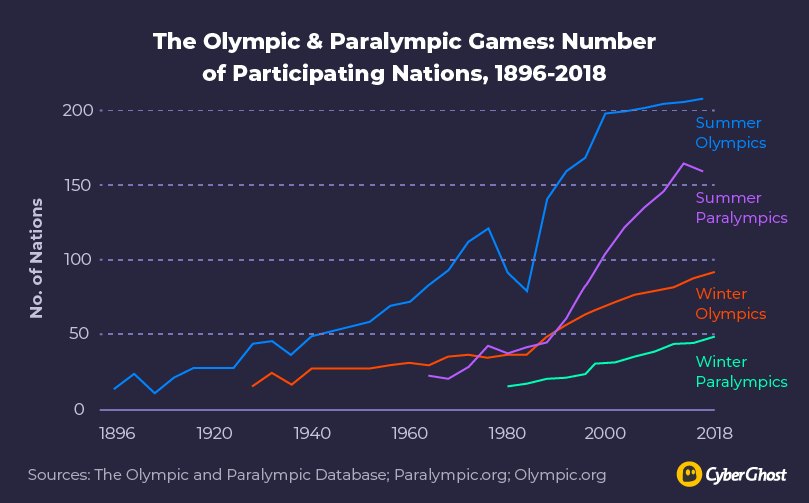
Every Olympic event has seen a steady increase in participation over the last 100 years or so.
The Summer Olympics is the biggest of all events when it comes to participation. 207 nations participated in Rio 2016.
The PyeongChang 2018 Winter Olympics achieved record participation for a Winter Games, with 92 nations taking part. Yet, as a general theme, more nations participate in the Summer Games. Rio 2016 had a 77% higher participation rate than PyeongChang 2018, owing to the fact winter sports are not possible in many nations.
More nations participate in Summer and Winter Olympic events compared to Paralympic events, too. The Rio Olympics had 26% more participating nations than its Paralympic counterpart (159 competing nations), while South Korea’s 2018 Winter Olympics (92 nations) had a 60% difference in competing nations compared to its Paralympics (49 nations).
Top 15 Most Successful Olympic Nations
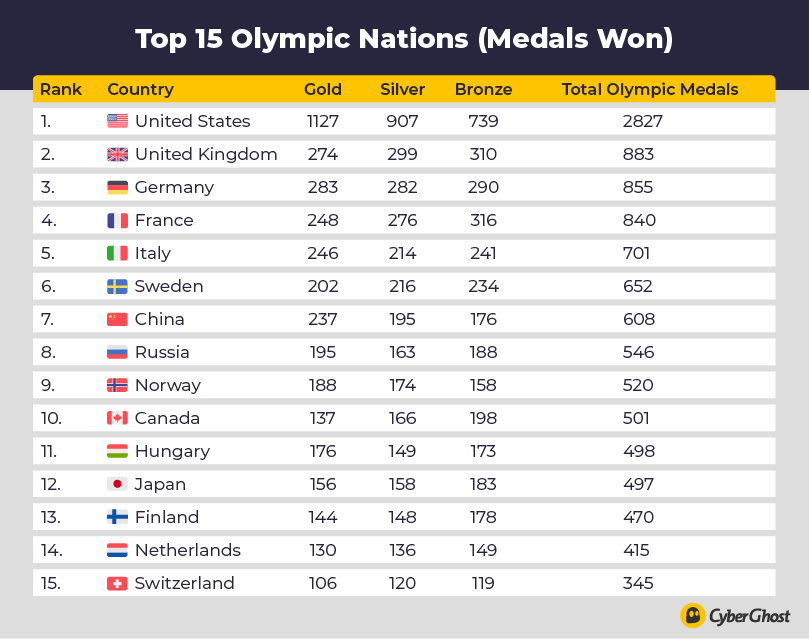
Which nations enjoy the most success at the Olympics?
On the whole, the United States team performs the best across both Summer and Winter Games. The United Kingdom also achieves a high medal count, as do Germany and France.
Some of these successful nations owe their success to their domination of the Winter Games.
Norway is the best Winter Olympics performer. Norway’s 368 total medals are enough to keep the nation ahead of the USA (305 winter medals) and Germany (240 winter medals).
Other winter specialists include Austria (232 winter medals), Sweden (158 winter medals), and Switzerland (153 winter medals).
The Overachievers
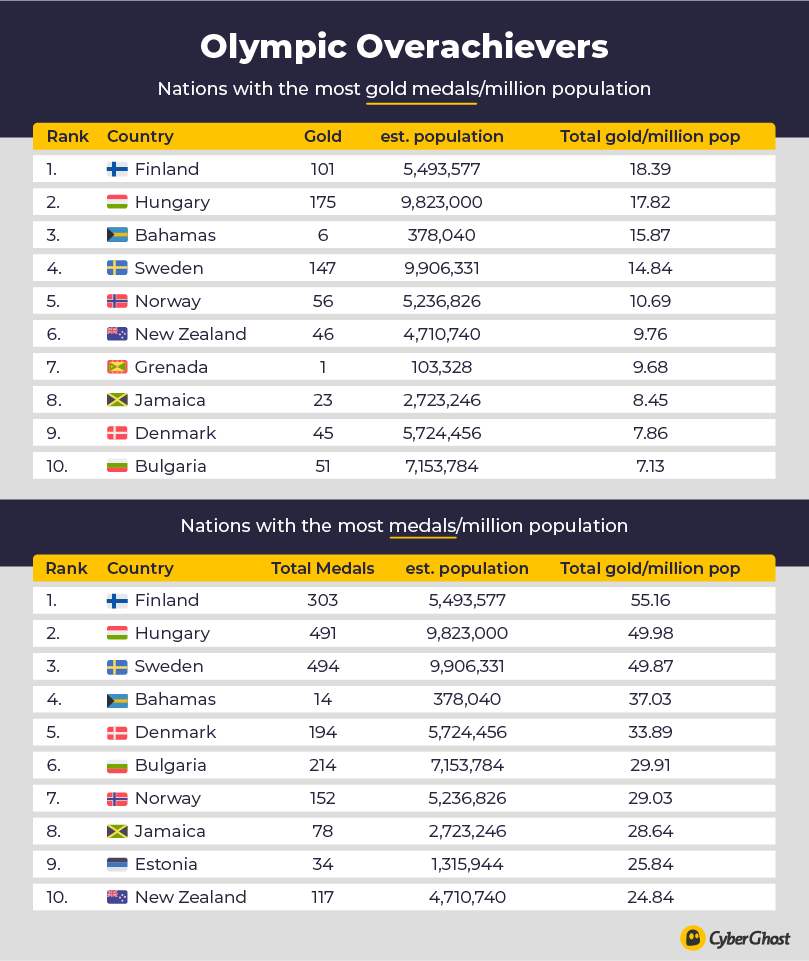
Some of these nations also feature on the list of Olympic overachievers, owing to their expertise in winter events.
Finland has claimed 101 golds and 303 total medals with a population of just 5.5 million. Hungary has won 491 Olympic medals with a population of 10 million people. That’s nearly 50 medals for every million people.
Other notable overachievers include the Bahamas, which has won 14 medals despite having one of the smallest populations on this list. Sweden, meanwhile, has a comparable record to Hungary – with nearly 500 medals and a 10 million-strong population.
Sports at the Summer Olympics
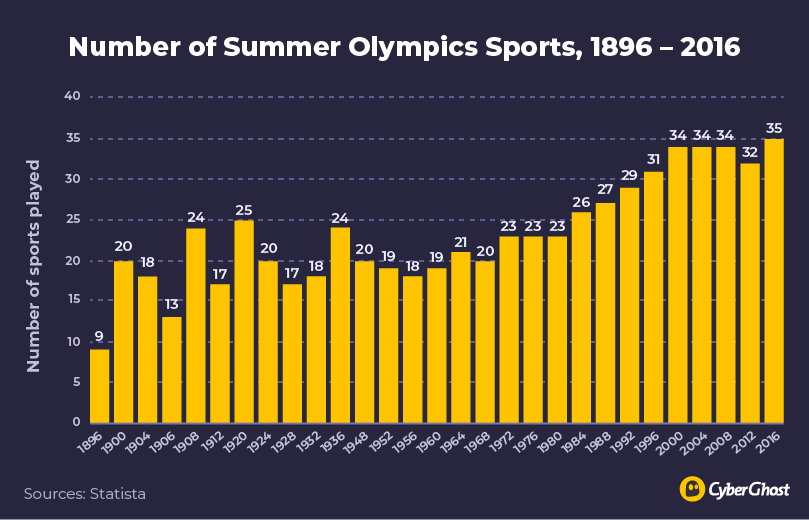
The Summer Olympics has seen significant growth in sports and events since 1896. The Olympic Games began with just 9 competitive disciplines. In 2016, Rio had 35 different sports – a three-fold growth.
Some “sports” have been dropped over time. Artists actually competed in the Olympics from 1912 to1948. Painters, sculptors, writers, and musicians could all win Olympic medals for their efforts.
Events at the Winter Olympics
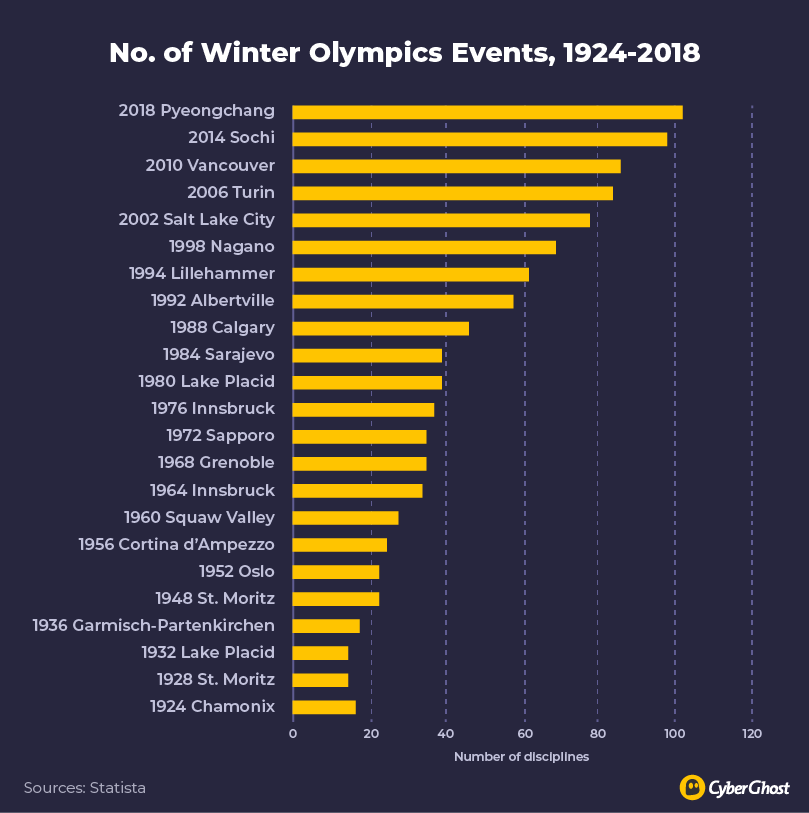
Perhaps it is best to measure the growth of the Winter Olympics by the number of individual events. There has only been one additional sports discipline added to the Winter Games calendar since its inception in 1924. In 2018, PyeongChang featured 7 sports disciplines in total.
However, the number of different events at the Winter Olympics has increased exponentially.
The Winter Olympics began with 16 events in 1924. In 2018, that figure reached 102 – a record for the Winter Olympics and a 537% increase since 1924.
Summer Sport Dominators
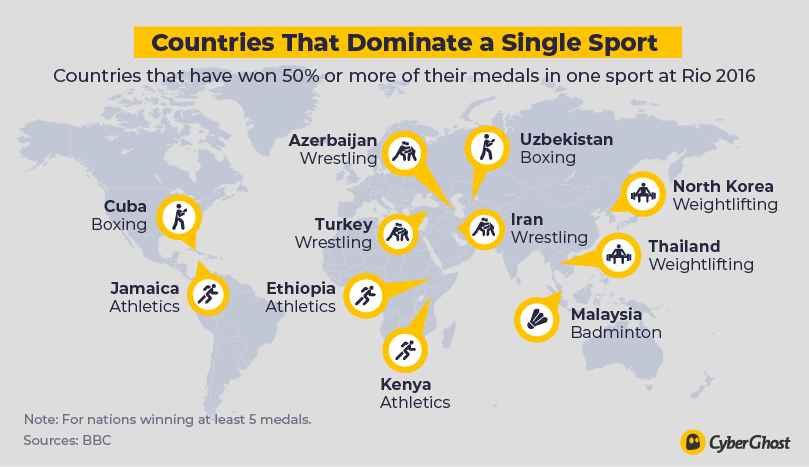
We’ve mentioned countries that are really good at the Winter Games. Well, some countries are exceptional at a single sport.
All of the above nations won 50% or more of their medals in a single discipline at Rio 2016. Cuba, for example, is renowned for its boxers, while Jamaica dominated track & field events for yet another year.
Azerbaijan, Turkey, and Iran are known experts at wrestling, and Kenya and Ethiopia have produced exceptional long-distance runners for years.
Thailand and North Korea have weightlifting prowess, and lastly we have Malaysia. The nation has won the majority of its Gold medals in Badminton.
Winter Sport Dominators
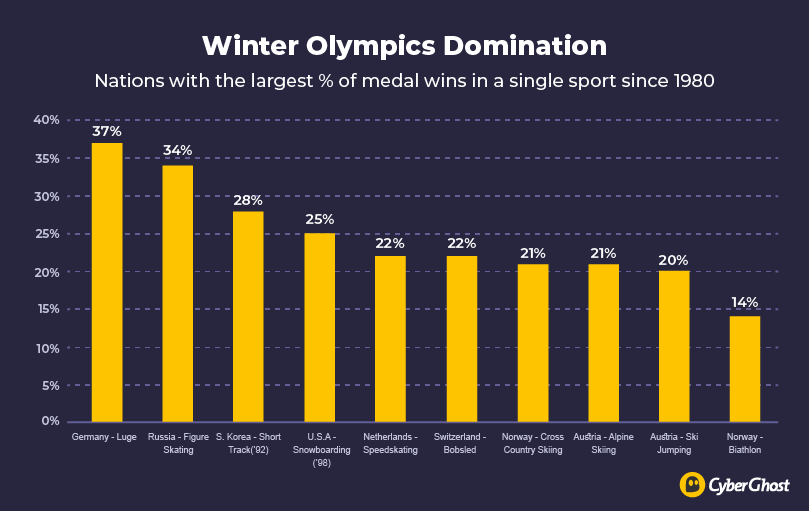
This data, collected up until the 2014 Sochi Winter Olympics, shows the Winter Olympics nations that dominate a single sport.
Germany is the best at luge, earning 37% of all luge medals since 1980. Russia is, of course, fantastic at figure skating, hauling 34% of the sport’s medals over the same period. Evgeni Plushenko is one of a long list of successful Russian skaters, with 4 Olympic gold medals to his name.
Elsewhere, South Korea dominates short track disciplines, the USA has some of the best snowboarders, and the Netherlands has become famous for its speedskating stars in recent years.
How Far Does the Summer Olympic Torch Travel?
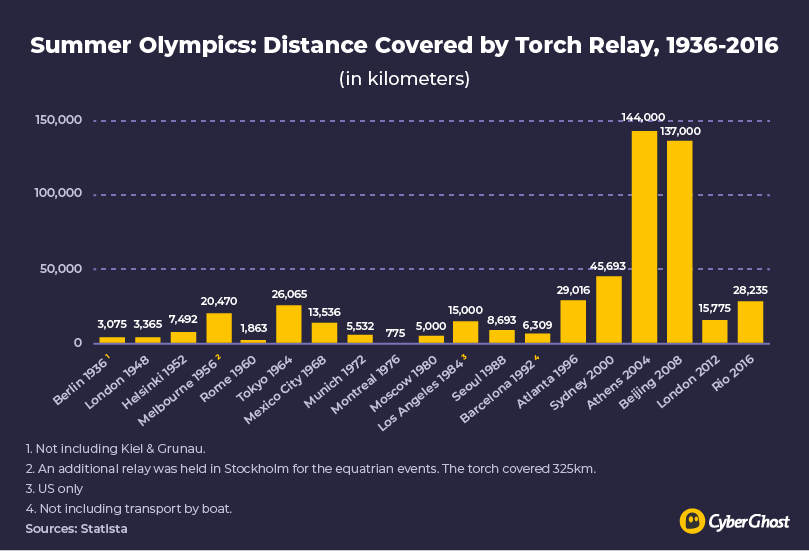
Although Amsterdam’s 1928 Olympic Games featured the first lighting of the Olympic torch, the 1936 Berlin Games had the first Olympic torch relay.
In 1936, the torch started in Olympia, covering 3,000 kilometers before finishing in Berlin for the Olympic Games.
The longest summer relay was Athens in 2004. The Olympic torch traveled across each habitable continent visiting major cities and former/elected Olympic host cities. Organizers wanted to highlight the global appeal of the Olympic Games, as well as its origins in Ancient Greece.
In 1956, Stockholm’s Equestrian Games led to an additional relay in Scandinavia. Dressage silver medallist Lis Hartel carried the Olympic torch along the streets of Copenhagen on horseback. The torch was then transported to Malmo, where 16 Swedish Equestrian clubs carried the flame to Stockholm.
Did you know? The Olympic torch has even traveled to space on several occasions, though, for safety purposes, it hasn’t ever been lit at these times.
How Far Does the Winter Olympic Torch Travel?
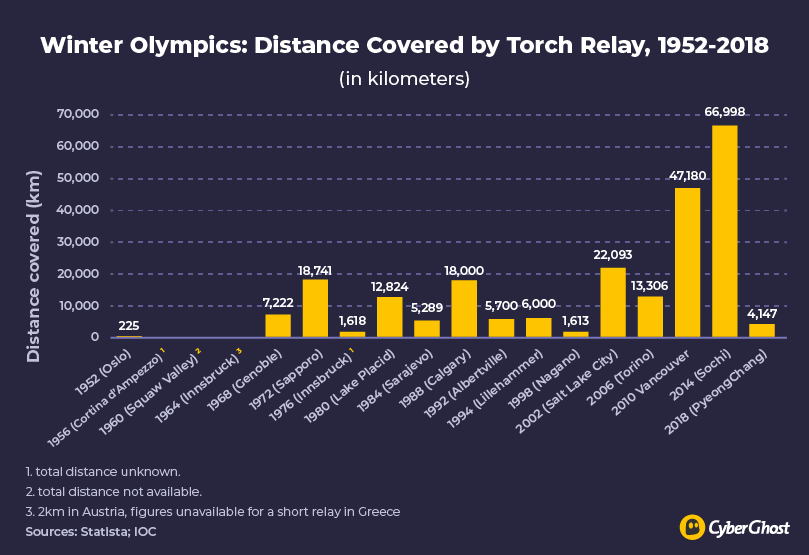
The first Winter Olympics torch relay was held at Oslo 1952. It was conducted by 94 participants, all traveling via skis. The relay lasted less than 2 days, with the torch covering just a little over 200km.
The longest winter relay was Sochi (2014), when the Olympic torch covered 77,000km. PyeongChang’s Olympics had the shortest torch relay of recent years, covering just 4,147km.
Top 10 Most Expensive Olympic Stadia
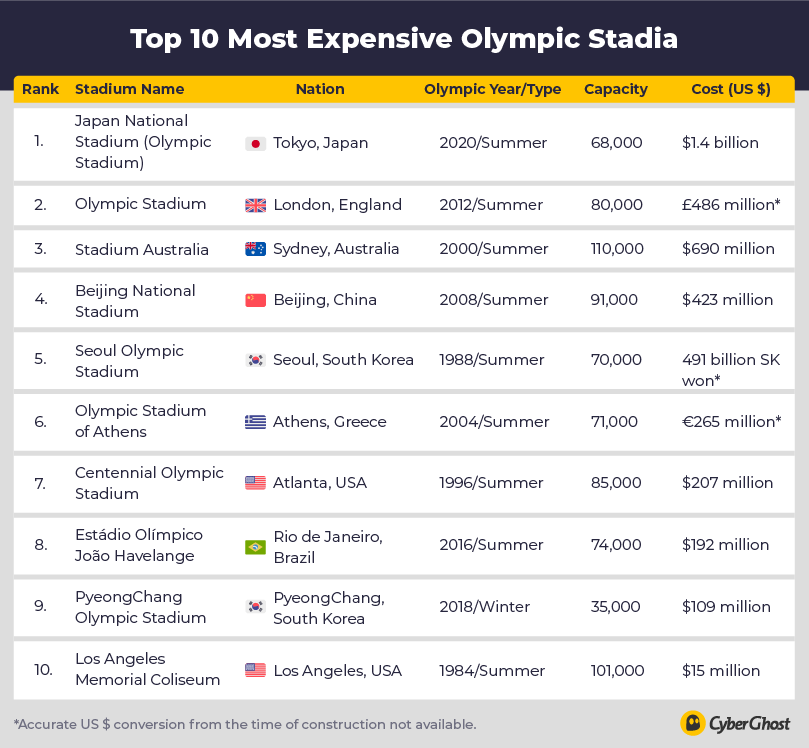
Olympic stadia typically host the opening and closing ceremonies of an Olympics, along with events like track & field and soccer. As you can see, they can rack up some hefty construction costs.
Top of the list is Japan’s freshly built National (or “Olympic”) Stadium. Unfortunately, COVID-19 restrictions mean the venue won’t see any spectators at this year’s Olympics.
Sydney’s Stadium Australia is considered one of the greatest Olympic venues. Around 112,524 spectators packed into Stadium Australia for Day 11 of the 2000 Olympics – for track & field – which remains a single-event record attendance at an Olympics to this day.
PyeongChang’s 2018 Olympic stadium was temporary – an ingenious design that avoided any long-term upkeep costs. Athens’ stadium, meanwhile, was a contributor to the Greece Olympics’ soaring costs. Damages were eventually felt by Greece’s economy.
The Most Expensive Olympic Games
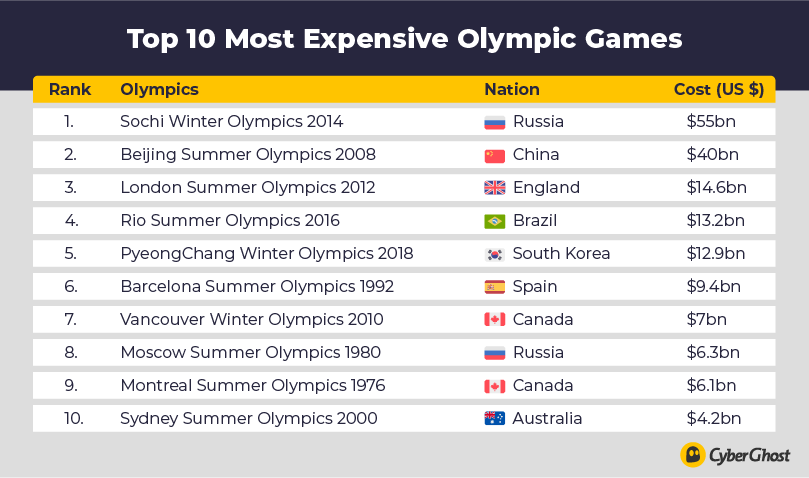
The Olympics can be a massively expensive event to organize. The true cost of the Olympic games is often not fully realized until years after the event, with venue costs and outstanding payments continuing over time.
Recent games have cost tens of billions of dollars. PyeongChang 2018 cost a grand total of $13 billion and is generally considered a huge success. PyeongChang cost four times less than the Sochi Winter Olympics in 2014, which is the most expensive Olympics to date.
Beijing was also a resounding success, yet racked up costs of up to $40 billion.
Many Olympic host nations set their budgets low but costs can quickly skyrocket. Rio 2016, for example, set out with an original budget of $8.8 billion, although the games ended up costing more than $4 billion more.
The Tokyo Games also looks set to miss its budget by a long shot, though, more on that a little bit later.
Tokyo 2020 Statistics
From planning to COVID-19 disruption: Tokyo 2020 is shaping up to be an awkward event in more ways than one. Here are some key statistics about Tokyo 2020.
Number of Sports at Tokyo 2020

There are 33 sports disciplines penciled in for the Tokyo 2020 Olympics, and a further 22 disciplines in the Tokyo 2020 Paralympics. So, what’s new for Tokyo 2020?
The Japanese people love baseball and softball. The two sports make a return to Tokyo 2020 after a 13-year hiatus from the competition. Surfing is another new Olympic sport. Surfing events will take place at Shidashita beach – some 40 miles (64 km) from Tokyo.
Karate, sport climbing, and skateboarding are three more hotly anticipated new sports featuring at this summer’s Olympic Games. Wrestling, meanwhile, was initially dropped from the Olympic roster but was quickly reinstated by the IOC. No events will be dropped for 2021.
Projected Number of Athletes at Tokyo 2020
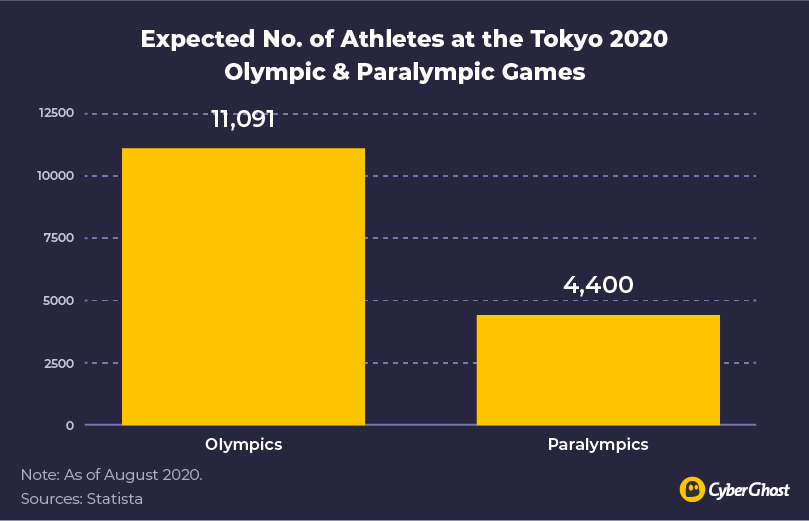
Tokyo 2020 looks set to come close to Rio’s record athlete participation. Around 15,491 total athletes are scheduled for the Tokyo 2020 Olympic and Paralympic Games. That’s close to Rio’s total of 15,571, though Tokyo may just fall short of the record.
New Venues at Tokyo 2020
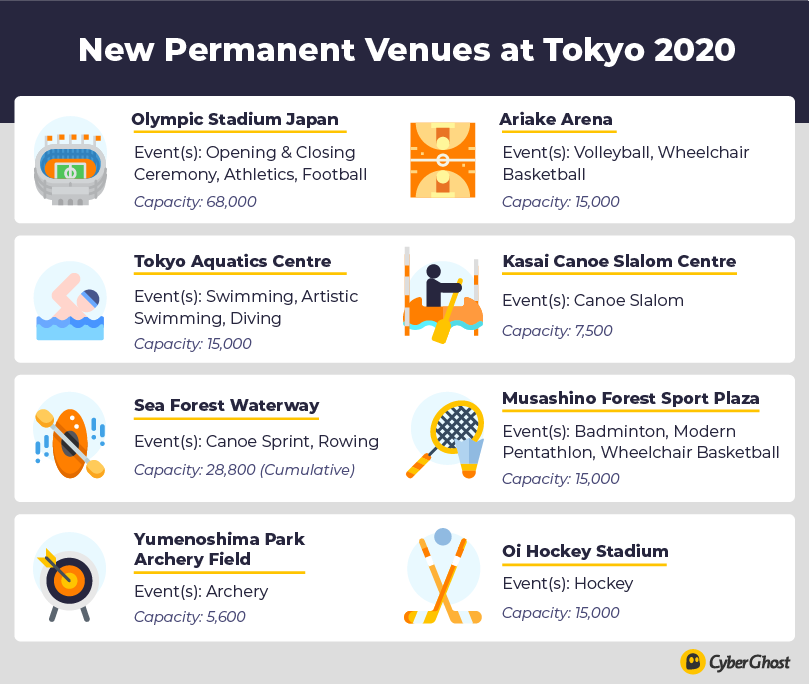
Japanese organizers have been busy building many fantastic new venues for the Tokyo 2020 Olympics, the biggest of which is the “Olympic Stadium Japan.” The old National Stadium has been demolished and rebuilt to make the Olympic Stadium (officially the “National Stadium”). This is where Japan’s opening and closing ceremonies will be held.
Other great new permanent venues include the Aquatics Centre, a $540 million project, and the impressive Kasai Canoe Slalom Centre ($65 million). On top of these 8 new permanent venues, Tokyo 2020 has also constructed 10 new temporary venues – including an urban sports park that will house extreme sports events.
Tokyo 2020 Projected Costs
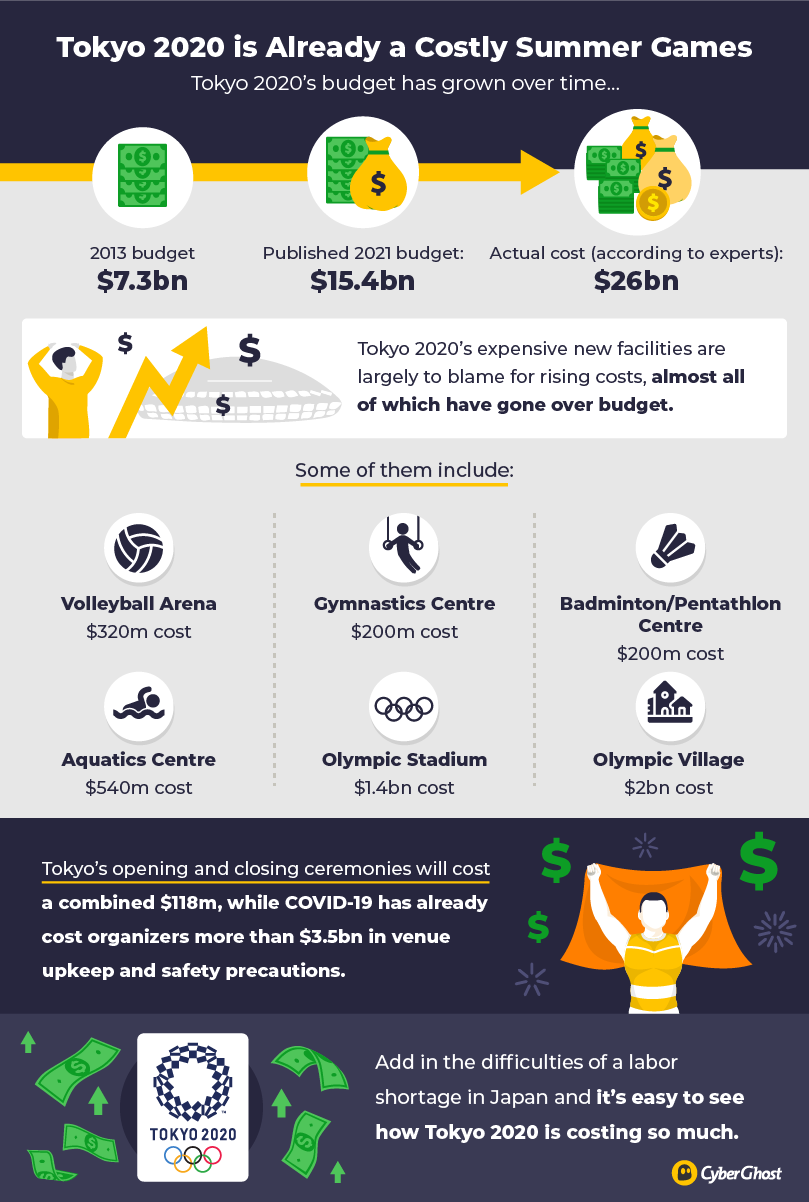
Tokyo 2020 has gone wildly over budget. A combination of factors are leading to a bill that could rise to $26 billion. That’s nearly $19 billion more than what was originally planned.
The cost of Tokyo 2020’s new venues is one factor. Japan has paid over budget for practically every Olympic venue that’s been built, with its Japan National Stadium costing a whopping $1.4 billion. Tokyo’s Ariake Gymnastics Centre is another project set to smash past its expected cost, ending up $120m over budget. A labor shortage in Japan is also playing its part in rising costs.
Economically, Japan cannot consider canceling Tokyo 2020. Although some recent events (such as Wimbledon 2020) actually turned a profit from cancellation, Japan would recover just $2-3 billion if Tokyo 2020 were canceled. Not exactly small change, but nowhere near enough to cover the overall cost of the event.
The Impact of COVID-19 on Costs
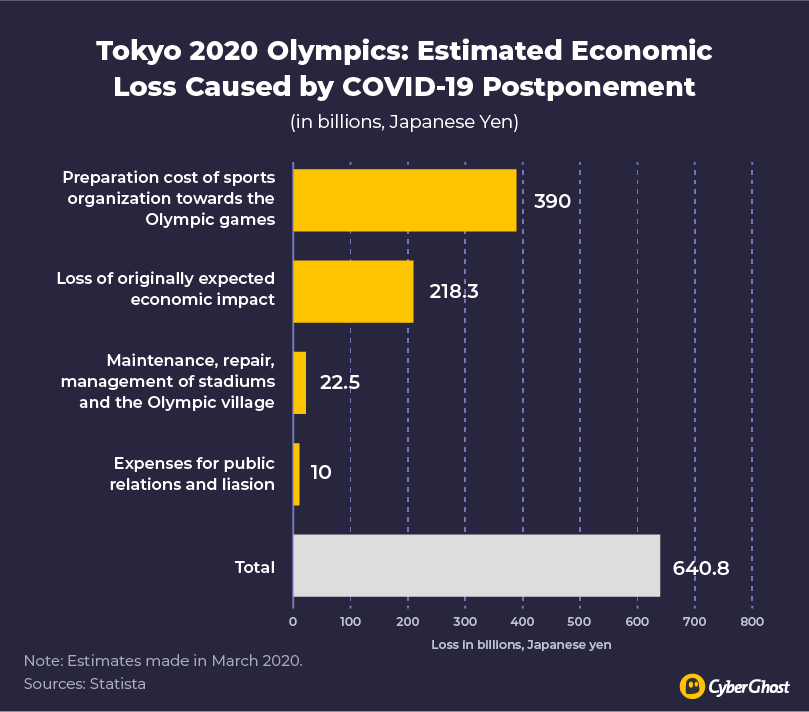
Estimates made in 2020 chart the expected losses of postponing the games another year due to the COVID-19 pandemic. Preparing for the new event could ultimately cost around 400 billion Japanese Yen, with venue maintenance and general costs of the pandemic also having a significant impact.
The increased rent and upkeep costs from COVID-19 postponement have added $2.8 billion to the total cost so far, while COVID-19 precautions (tests, sanitizing, etc) are costing an extra $900 million. In total, estimates suggest that COVID-19 could cost Tokyo 2020 a total of around $5 billion.
So far, these estimates are holding true. COVID-19 precautions and additional venue rent and upkeep have already added well over $3.5 billion to Tokyo 2020’s cost.
Tokyo 2020 Estimated Revenue
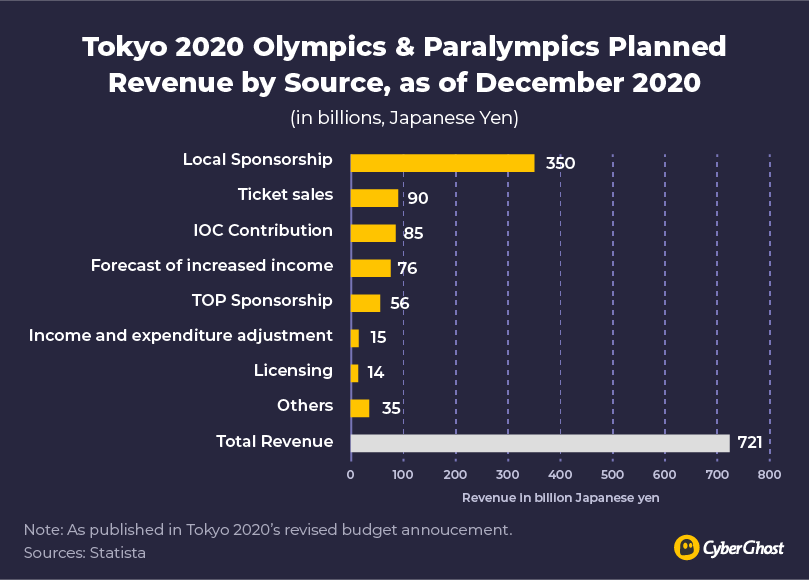
Planned revenue figures of 721 billion Japanese Yen taken from December 2020 now look optimistic at best. Sponsorship and marketing money makes a huge portion of expected income, as do ticket sales.
However, the revenue potential of the games has been thrown into disarray. For a start, Japan will receive almost no share of Tokyo 2020’s broadcast rights – usually one of the biggest money-makers for host nations and the IOC. Japan’s recent announcement that there will be no spectators at the Tokyo games will also lead to an $800+ million loss in revenue.
Canceled warm-up events play a part in lost ticket revenues, too. Less-than-expected spectator engagement will damage consumer spending, as well as the marketing potential of Tokyo 2020 (as will the Japanese public’s general opposition to the games). Event-related spending could be down by as much as 90%.
Overall, a combination of these factors could result in a $23.1 billion loss for Japan. Ouch.
Public Opinion of Tokyo 2020
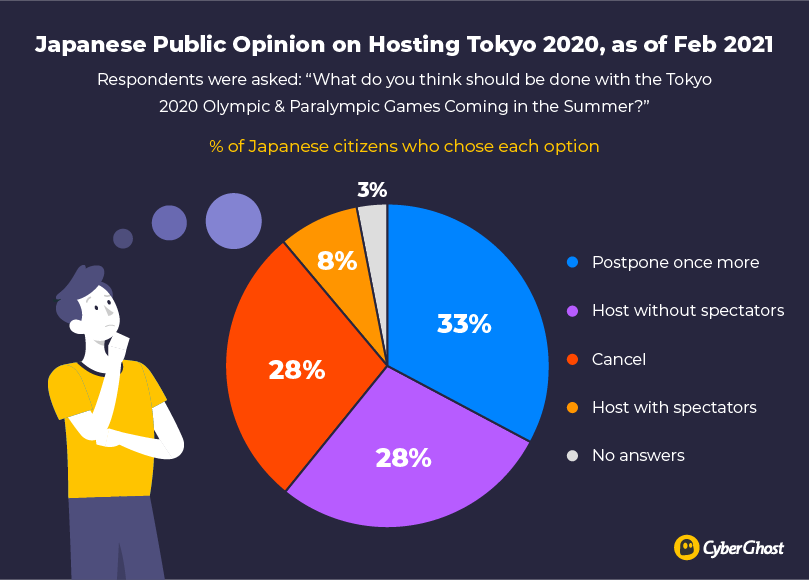
Japan’s hosting of the Olympic Games is one of the most contentious decisions of late. Japan has invested too much money to cancel the Games, yet Japanese citizens are overwhelmingly opposed to the Tokyo 2020 games going ahead this year.
Tokyo 2020 comes at a time when Japan is still under a wave of COVID-19 infections. Japan is in lockdown, and many citizens are now skeptical about the safety of hosting the Olympics.
28% of Japanese citizens say Tokyo 2020 should be canceled, another 33% believe Tokyo 2020 should be postponed another year.
Attendance at Tokyo 2020
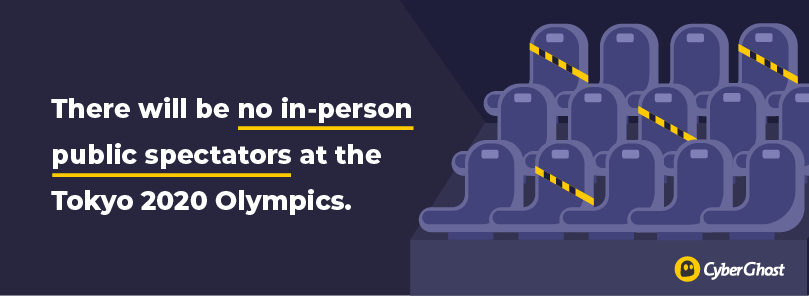
Before Tokyo 2020, officials were hopeful of socially distanced crowds in venues.
Initially, the Japanese government set a 10,000 capacity limit for Olympic events, or 50% of the venue’s capacity (whichever is lower). Japanese officials also considered lowering this limit to 5,000 capacity, with unattended time slots. However, it now looks as though no spectators will attend Tokyo 2020.
Tokyo organizers already banned all overseas spectators on March 20th 2021. Japan is still grappling with the COVID-19 pandemic, and all Olympic events will now be conducted without a crowd. Victorious athletes will even be required to put their medals around their own neck at Tokyo 2020.
The Olympics’ low-attendance is desperately unfortunate. Tokyo’s plethora of excellent purpose-built stadiums and sports halls are perfect for welcoming victorious athletes, though, this is the way of the world in 2021.
How Many Athletes Are Vaccinated at Tokyo 2020?

The Japanese government is desperate to vaccinate Tokyo 2020 participants, as Japan suffers from high case rates and low vaccination rates. An outbreak of COVID-19 at the Olympics could be catastrophic.
The IOC wants athletes fully vaccinated before they arrive at Tokyo 2020. This is difficult considering the varying success of vaccine rollouts around the world. In the United States, 90% of the US Swimming team has been inoculated since June, but securing doses is difficult in less developed nations.
The IOC began a global effort to vaccinate athletes in time for the Olympics back in January. Working with the World Health Organization, the IOC distributed Pfizer/BioNTech vaccines to Olympic teams from central areas in each country. Though, athletes are not forced to have the COVID-19 vaccine.
The plan looks set to work as officials predict high vaccination rates at the games. Vaccination is the best tool to quell the threat of COVID-19 for participants, staff, and volunteers. That being said, just 20% of the Japanese population have received a first vaccine as of early July 2021. Athletes, then, will have to stay in lockdown to avoid spreading COVID-19.
How Many Tests Will Be Administered at Tokyo 2020?

Around 200,000 COVID-19 tests will be conducted on athletes throughout the Tokyo 2020 Olympics. Testing is the best way to avoid outbreaks of COVID-19 in the Olympic village. Finding sources early means athletes can isolate, stopping the spread of COVID-19 throughout the camp.
The IOC has set protocols in the case an athlete or Olympic team tests positive for COVID-19. Individual athletes will be forced to withdraw from the competition should they catch COVID-19. In most team sports, a player or group of players that test positive are eligible to be replaced with other players.
In knockout rounds for hockey, rugby, and handball, teams that have an outbreak are replaced by the last opponent they defeated. The same rules apply in individual events, though in tennis, badminton and boxing, athletes receive a “bye” when opponents test positive.
Hopefully we don’t see too many athletes heading home at Tokyo 2020.
Athlete Statistics
Talented athletes are what makes Olympic competitions so special. Here are some statistics on Olympians.
How Many Athletes in the Olympics?

As with national participation, the Summer Olympic and Paralympic Games attract a greater number of athletes when compared to the Winter Olympic and Paralympic Games. The Olympic Games generally attract a greater number of athletes than the Paralympic Games.
For example, Rio 2016 Paralympics featured 4,333 athletes while 11,238 athletes attended Rio’s Olympics. That means the Rio Olympics had an 88% difference in athlete participation compared to its Paralympic counterpart.
Meanwhile, 2,833 athletes attended the PyeongChang Winter Olympics of 2018. That’s some 2,226 more participating athletes than PyeongChang’s Paralympics – an even greater percentage difference of 133%.
The Rio Olympics had a 119% difference in athlete participation compared to PyeongChang 2018 (11,238 vs. 2,833), while Rio’s Paralympics had a 154% difference compared to PyeongChang’s Paralympics in 2018.
The statistics show that Summer Games attract more athletes than Winter Games, a trend that remains consistent across Olympic and Paralympic events.
Who Are the Most Successful Olympians?
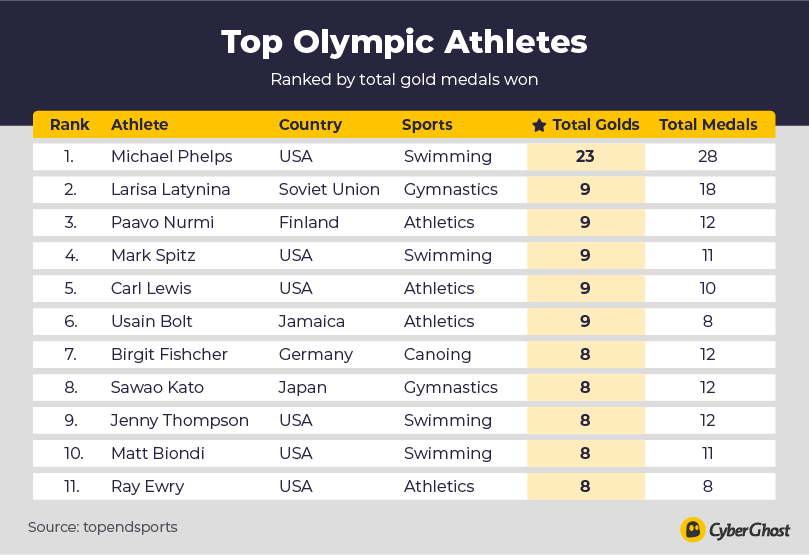
Who are the most successful Olympians of all time? Michael Phelps tops the list, with an astounding 23 Gold medals and 28 medals in total.
Phelps won an unprecedented 8 medals at Beijing 2008. In fact, swimmers feature heavily on this all-time list due to the high number of medals available in the sport. Mark Spitz, Matt Biondi, and Jenny Thompson are three more swimmers with a superb medal count. Still, Phelps has more than twice the gold medals as his nearest rival.
Spitz did, however, break the record for most Olympic golds at one Olympics (7 at Munich 1972). Meanwhile, Ray Ewry won all 8 of his gold medals in events that no longer exist at the Olympics (standing high jump, standing stripe jump, standing long jump).
Usain Bolt is perhaps the greatest Olympian of all time. Bolt won gold in the 100m sprint, 200m sprint, and 4x100m relay three games in a row. In 2008, he broke the world record across all three events and has broken 19 world records throughout his career.
Honorable mentions include the Soviet gymnasts Nikolai Andrianov (15 total medals, 3rd all-time) and Boris Shakhlin (13 medals), and Romanian gymnast Nadia Comaneci (9 medals) who scored an unprecedented perfect 10 from every judge at Montreal 1976.
Note: just 4 Olympians have won medals at both the Summer and Winter Olympics: Eddie Eagan (United States), Jacob Tullin Thams (Norway), Christa Luding-Rothenburger (East Germany), and Clara Hughes (Canada).
Olympian Demographics
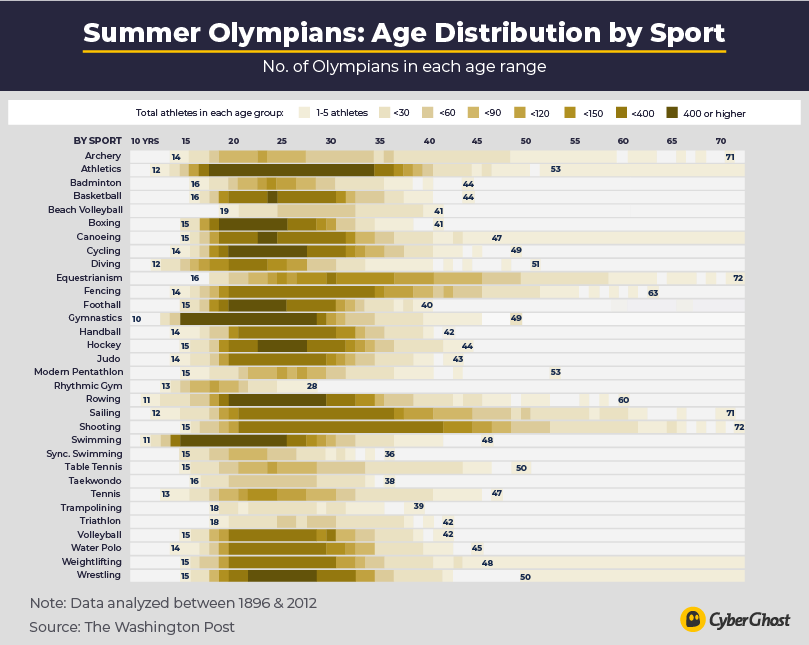
This chart shows the age range of Olympians up until the London 2012 Olympics. As you can see, the age range of Olympians can differ dramatically.
Archery, shooting, equestrian, and sailing events have a varied mix of ages. These sports are not as physically demanding as others, placing a greater emphasis on skill, technique, and coordination.
Explosive sports like swimming and athletics require competitors in peak physical condition, and this is generally true across most Olympic sports. 18-35 is the peak age range for an Olympic athlete.
Oldest and Youngest Competitors
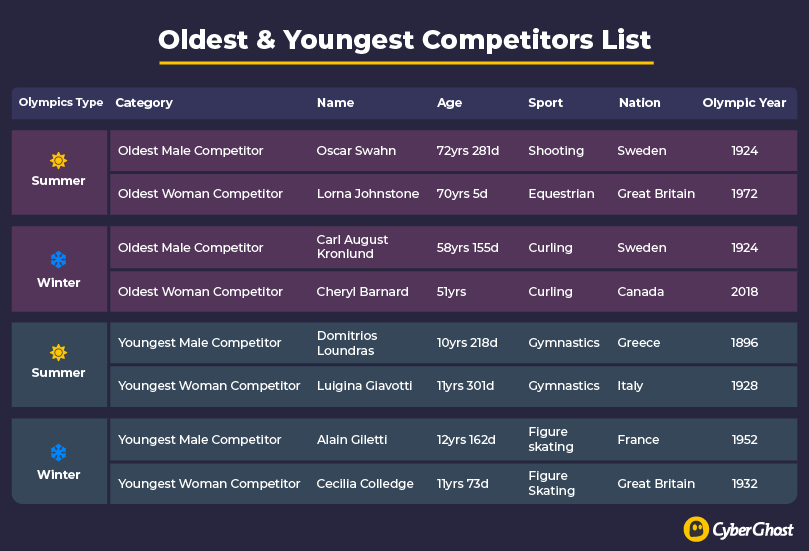
The oldest and youngest competitors list highlights some interesting themes.
As mentioned, sports that require less athletic prowess and more experience often feature older competitors. Oscar Swahn is one such example. The Swedish shooter was nearly 73 years old when he took part in the Paris 1924 Olympics.
Conversely, the youngest competitors often feature in disciplines that require balance, flexibility, and elegance. In the Summer Olympics, the youngest competitors are gymnasts and in the Winter Olympics, the youngest competitors are figure skaters. In general, Winter Olympians fall into a smaller age range than Summer Olympians.
Oldest and Youngest Medalists

Many of the oldest and youngest Olympic contestants also feature on the list of youngest/oldest medal winners. It seems, outperforming your age bracket is a sure sign of class in any given sport.
Oscar Swahn became the oldest Summer Olympic male gold medalist when he won in shooting at 64 years old. Oscar won again at the age of 72, cementing his status as the oldest male medalist at the Olympics.
Linda Peyton Pollock is another athlete whose gold in archery was enough to make her the oldest woman medalist/gold medalist at the Summer Olympics. Carl August Kronlund is not only the oldest male competitor at the Winter Olympics, he’s the oldest medalist, too.
The only bone of contention is the youngest male gold medalist category at the Summer Olympics. A young boy from Paris is thought to have won Olympic gold in rowing when he replaced the Dutch teams’ coxswain who was deemed “too heavy” at 60kg. The boy was thought to be around the age of 7, yet there was no confirmation of this, or whether he actually received the medal for that matter.
This couldn’t happen in 2021, of course. The Youth Olympic Games was started in Singapore in 2010 to provide a multi-sport event for promising youth athletes around the world.
Athlete Accommodations: The Olympic Villages
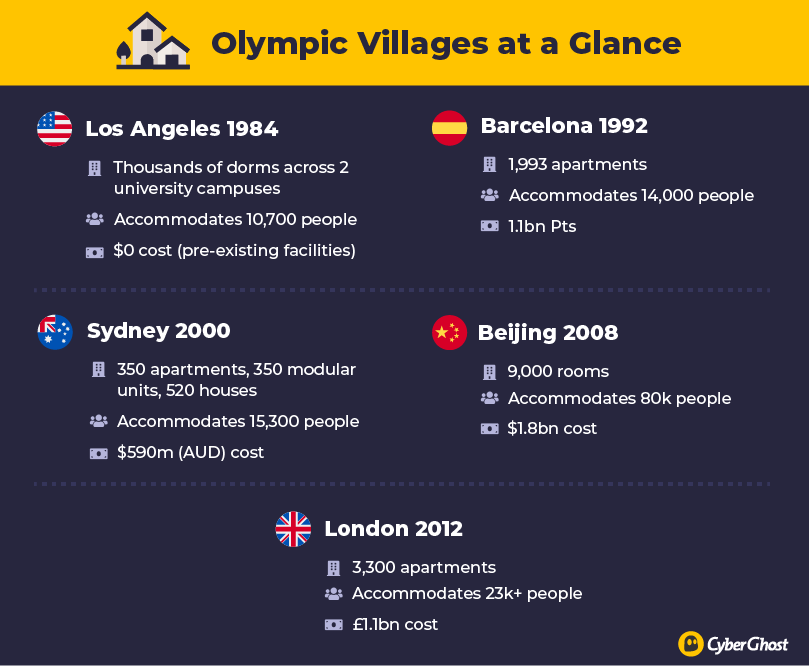
Paris 1924 had the first Olympic Games athlete village (Le Village Olympique). Paris charged competitors 30 francs per person for a bed (daily). Food, laundry, electricity, and a shower cost a further 25 francs.
Since then, Olympic villages have come a long way. Standout accommodations include Beijing 2008 – which many athletes likened to large-scale university accommodation, and London 2012, with its array of modern amenities.
Another standout accommodation is Sydney’s eco-friendly Olympic village built for the 2000 Olympics. Upon completion, Sydney’s athlete village was the largest solar-powered suburb in the world.
Online Dating During the Games
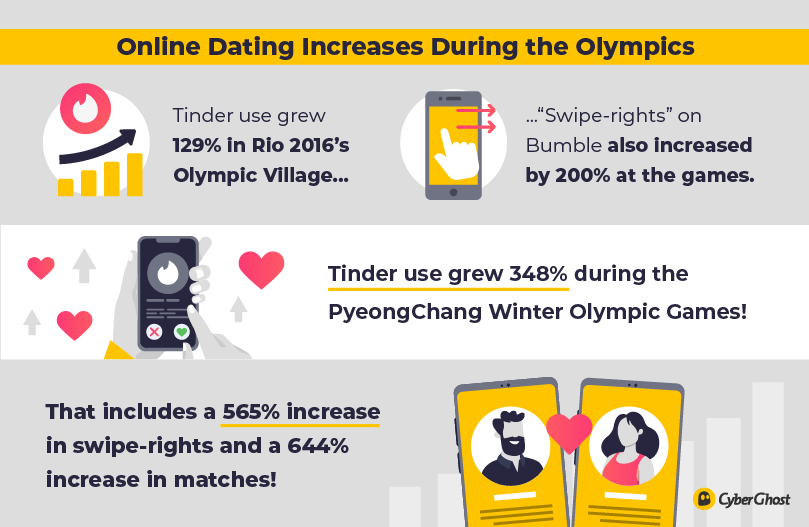
Olympic villages place thousands of athletically primed men and women into a relatively small space. It’s no surprise, then, that Olympic athletes are known for their game off the pitch, as well as on it.
Olympic athletes are not shy about hooking up during the games. In fact, “raunchy Rio” saw huge increases in the use of online dating apps – a good barometer of increased sexual activity.
The 2018 Winter Olympics saw an even greater increase in Tinder use, and the app even provided Olympians with free premium accounts during the games. According to Tinder, bobsledders, hockey players, snowboarders, alpine skiers, and skeleton racers were the male athletes with the most “swipe-rights.” Meanwhile, snowboarders, alpine skiers, bobsledders, lugers, and freestyle skiers were the most-swiped women athletes.
Athlete Attraction
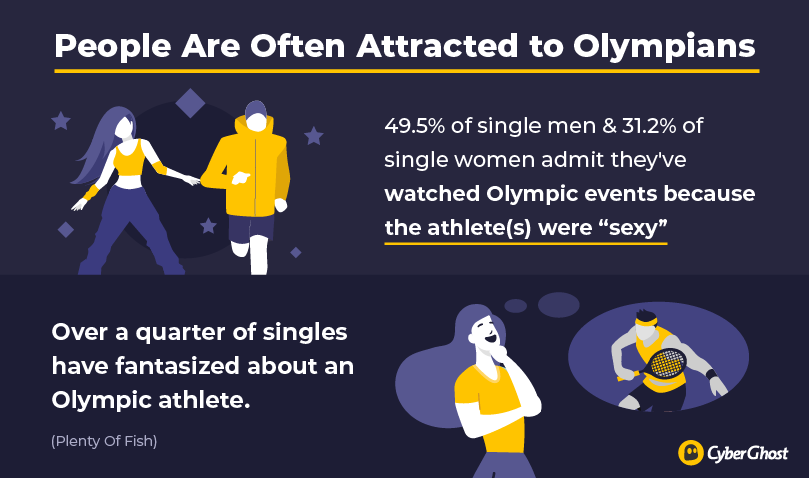
So why exactly are Olympians so sexually active during the games? They’re often quite attractive, for a start.
Olympians are in peak physical condition. Couple this with an increased calorie intake, increased adrenaline levels, endorphins, stress, and a close-knit Olympic village community – and you’ve got numerous reasons why athletes are making moves while at the Olympic Games.
According to Plenty Of Fish, people think figure skating and beach volleyball are the sexiest winter and summer sports. Curling and weight-lifting are generally considered the least attractive winter and summer sports respectively.
Safe Sex at the Games
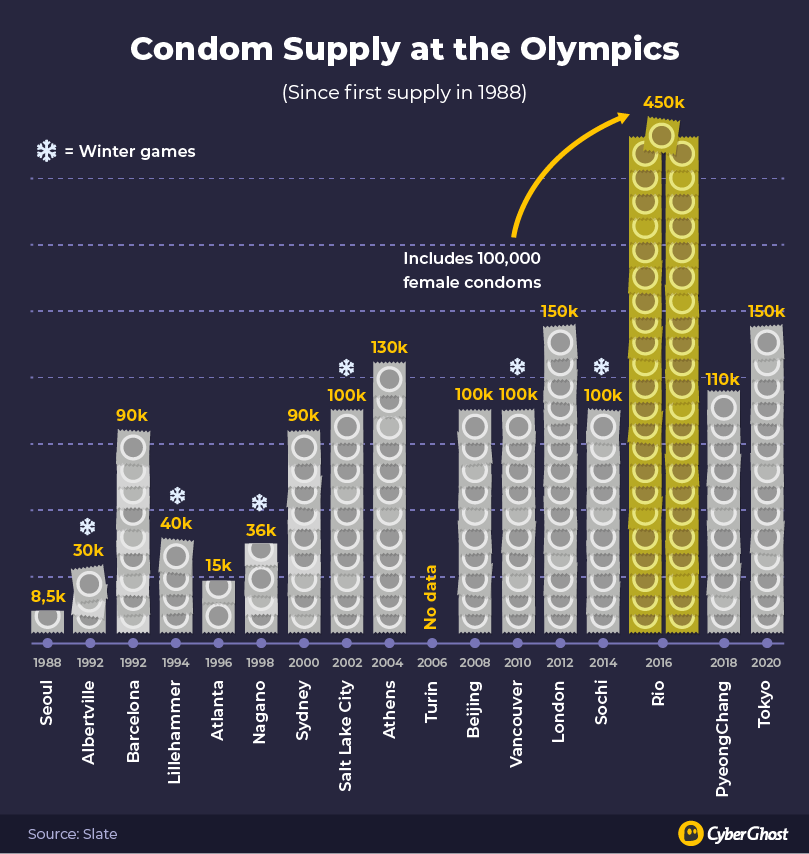
The IOC is fully aware of this dating trend among athletes. Since Seoul 1988, the Olympics has supplied thousands of condoms to athletes in a bid to keep sex safe.
Sydney 2000 famously ran out of condoms. After an initial 70 thousand condoms were used by athletes, Sydney’s organizers had to order 20,000 more.
Beijing comically branded its condoms with the Olympic motto: “Faster, Higher, Stronger.” A slogan that takes on an added meaning in the bedroom.
Rio stands out for the highest number of supplied condoms. A whopping 450,000 condoms were provided to athletes at Rio 2016 – that’s a record 42 condoms for every Olympian!
Rio’s total is 3 times higher than London 2012’s 150,000 condoms. PyeongChang also distributed a lot of condoms for the Winter Olympics. PyeongChang’s total of 110,000 condoms meant athletes were given 37 condoms each.
Olympic Dating in 2021
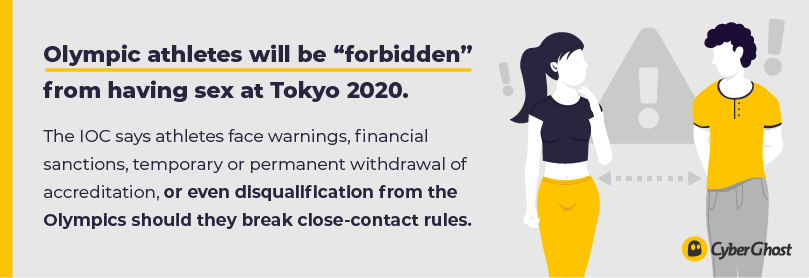
Dating won’t be straightforward at Tokyo 2020. The COVID-19 pandemic has made love difficult for many in recent years, and the Olympic Games will be no different.
Athletes will stay in single beds made out of cardboard – some sites claimed this was to discourage sex, but this was discredited by the Tokyo 2020 organizers. Athletes are also urged to adhere to strict social distancing rules as Tokyo aims to conduct a “safe and secure” event.
Tokyo 2020 officials received accusations of mixed-messaging following the announcement of their vast supply of 150,000 condoms for the games. Tokyo even responded by asking athletes to take condoms home rather than use them.
Audience Statistics
The Olympic and Paralympic Games receive the vast majority of their income from sponsorships, marketing, and broadcasting revenue – so the Olympic audience is really important.
A Global Event
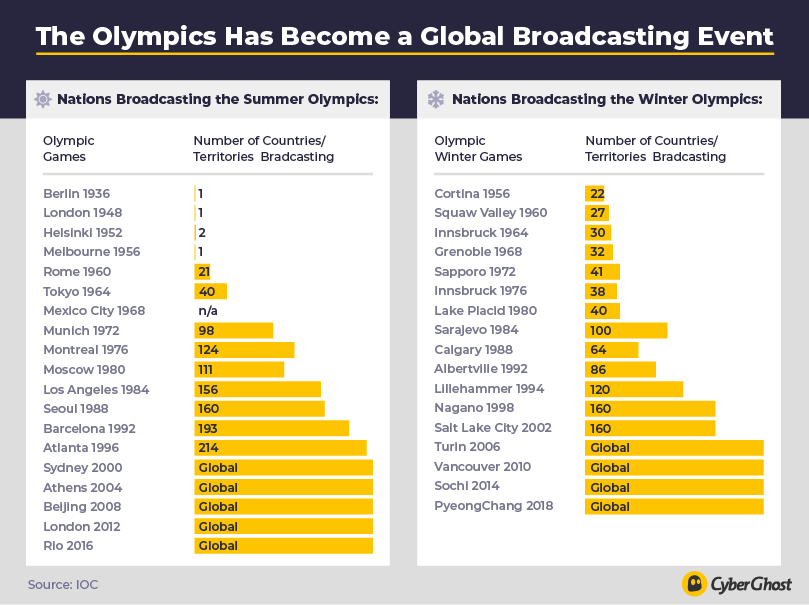
The Olympics has gained in popularity exponentially since nations began to broadcast the games.
Over the last 20 years, the Olympics has become a truly global event. Sydney 2000 marked the first time the games were broadcast in every nation across the globe, and in 2006, the Winter Olympics achieved the same feat.
How Many People Watch the Olympics?
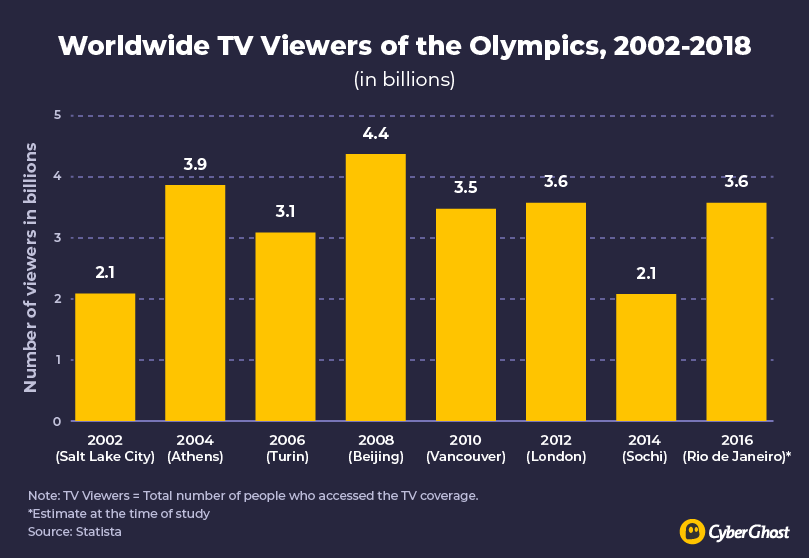
The Olympic Games have been televised since the 1936 Berlin Games. Rome 1960 marked the first occasion during which the Olympics was broadcast in the U.S.
The Olympics has received record viewership over the last few years. Beijing 2008 stands out as the most-watched Olympics of all time, attracting a total viewership of 4.4 billion. That’s more than half of the world’s population.
Athens, Rio, and London 2012 are not far behind. The stats also indicate that the Summer Games receive better viewership than the Winter Games, perhaps owing to its popularity, higher quantity of sporting events and increased broadcasting hours.
Streaming Online vs. TV (A Changing Trend)
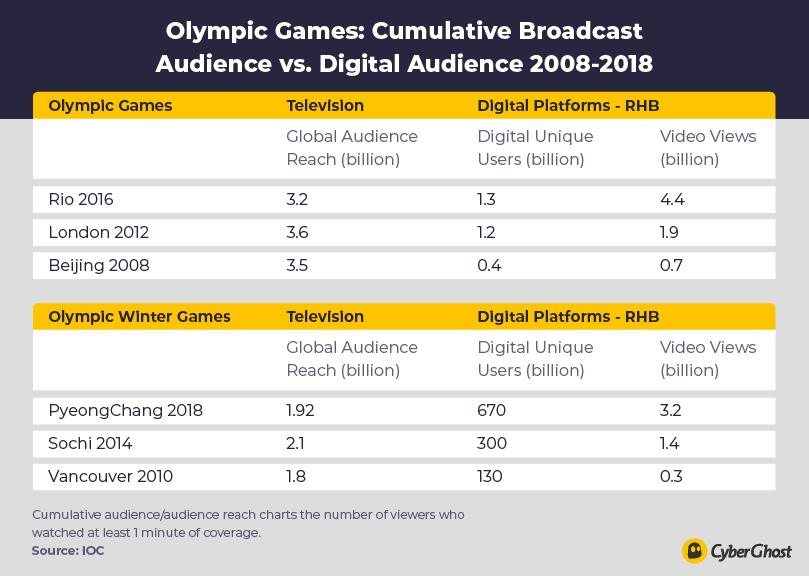
Recent statistics on cumulative audience reach tell a different story.
Streaming will become the dominant method of watching the Olympics in years to come. On-demand digital video has surged into mainstream popularity in recent times, and stats show that viewers are continually choosing to watch the Olympics online.
Rio’s TV audience reach fell 11% compared to the London 2012 Olympics, meanwhile, unique digital viewership grew from 1.2 to 1.3 billion and video views rose a staggering 132%.
The same trend is visible in Winter Olympic viewing statistics. PyeongChang’s TV viewership fell, however digital viewership and online video views both more than doubled compared to Sochi 2014.
Expect this to continue at Tokyo 2020. In an amdocs study, 28% of U.S. consumers say they will watch the games via streaming. Another 16% will watch Tokyo 2020 on social media, and 15% via on-demand channels.
Which Sports Do People Want to Watch the Most?

U.S. adults are most interested in watching gymnastics, swimming, and beach volleyball at the Tokyo2020 Olympics. Athletics came fifth, while baseball and surfing are the two most popular new events for 2021.
The results are fairly consistent with global viewing hours from previous Olympics, even though different nations often enjoy different sports.
Track & field’s 2.3 billion viewing hours at London 2012 make it the most viewed sport of all. Swimming came second, with 1.5 billion total viewing hours and gymnastics came third, with 1.442 billion viewing hours.
Sailing (87 million hours), trampoline (67 million hours), and modern pentathlon (32 hours) received the worst viewership of London 2012, – though, there’s a direct correlation between viewership and the number of events. Athletics held 47 events at London 2012. Trampoline and pentathlon held 3.
Who Wants to Watch the Olympics?

What are the demographics of your average Olympic viewer? Quite wide-ranging, as you can imagine, given the popularity of the games.
More than 60% of U.S. adults plan to watch at least some of Tokyo 2020. Millennials make up the most avid Olympic viewers; 30% of them plan to watch “a lot.”
Across the board things are fairly even, though, with Gen Zers having the smallest expected viewership demographic. Only 52% think they will watch the Tokyo 2020 Olympics, less than any other age group.
The Biggest Olympic Attendances
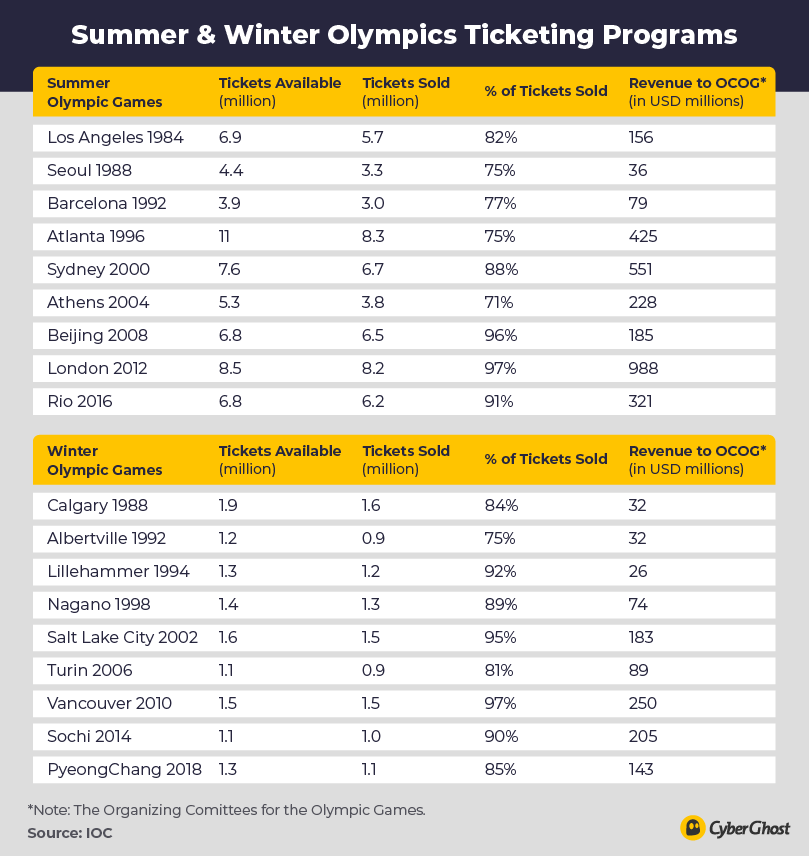
Atlanta currently holds the Guinness World Record for the highest in-person attendance at an Olympic Games. 8.3 million people bought tickets to watch the games, just beating London 2012’s figure of 8.2 million tickets sold.
Calgary 1988 is still the Winter Games with the highest volume of tickets sold and, in keeping with viewership stats, the Winter Games generally have lower attendance than the Summer Games.
Athens 2004 had the worst ticket sales of any Summer Games in the last 40 years while Albertville 1992 and Turin 2006 are two of the lowest attended Winter Games of recent memory.
Most Viewed Summer Opening Ceremonies
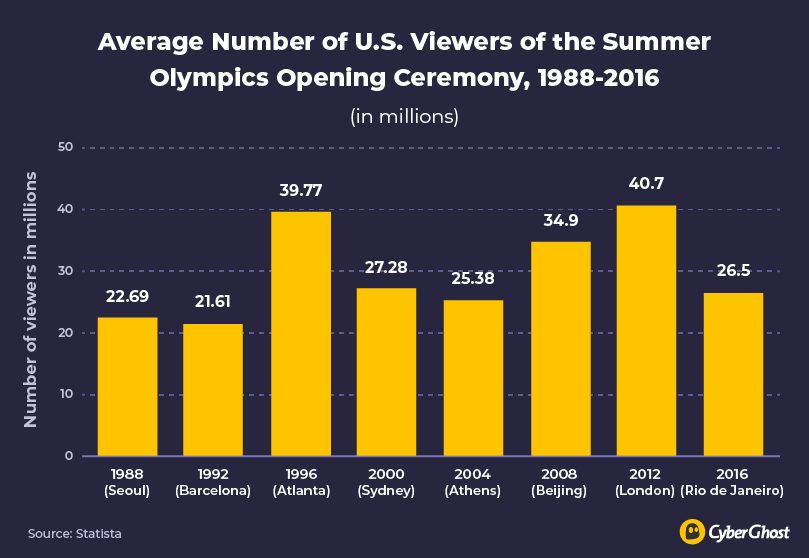
Opening ceremonies kick Olympic events off in style. Olympic hosts invest a lot of money to make sure they put on a fantastic show, so let’s take a look at the most-viewed Summer Olympic opening ceremonies of recent years.
U.S. viewership figures rank Atlanta 1996 and London 2012 as the two most-viewed opening ceremonies of recent years.
London 2012 is the most-viewed opening ceremony audience of all time, attracting an estimated global audience of 900 million people. It featured James Bond actor Daniel Craig, and a comical scene in which an actor dressed as Queen Elizabeth II parachuted into London’s Olympic Stadium.
Most Viewed Winter Opening Ceremonies
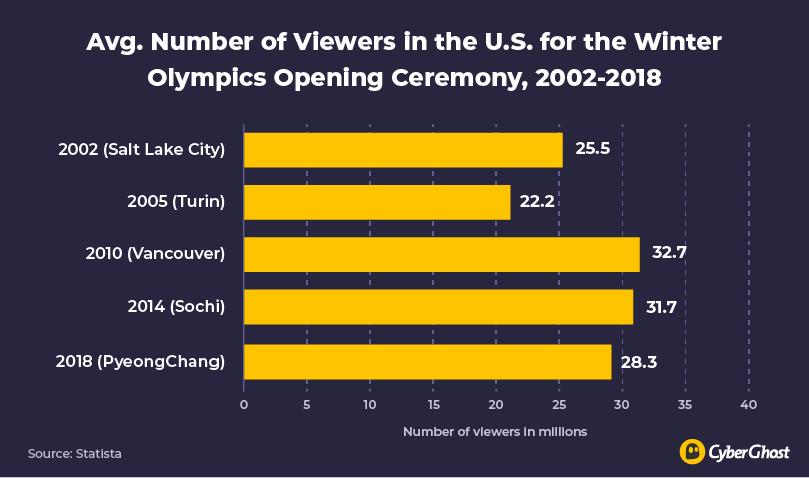
Recent Winter Olympics opening ceremonies have also garnered massive viewership – almost as much as their summer counterparts.
Vancouver 2010 stands out as the top-viewed Winter Olympic opening ceremony. Sochi and PyeongChang enjoyed huge U.S. viewership, too. Sochi 2014 is the only non-U.S. ceremony to break the 30 million viewers mark on this list.
Global Sponsorship
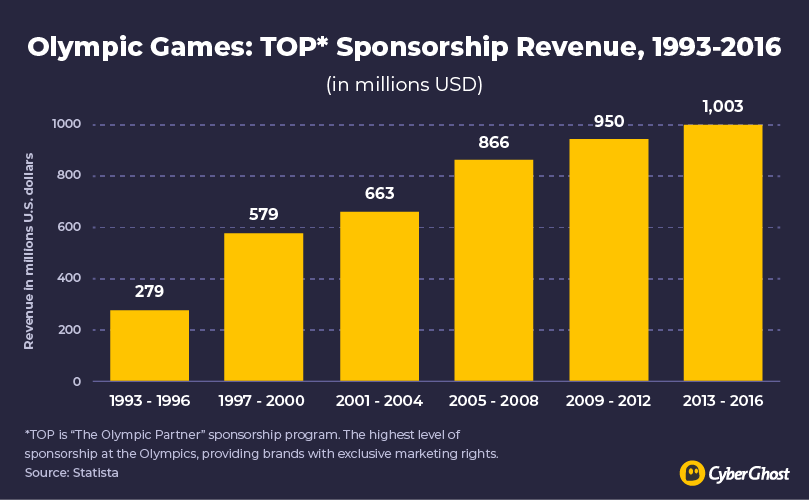
“The Olympic Partner” (TOP) sponsorship is the International Olympic Committee’s premium sponsorship program.
Olympic sponsorship works in a four-tier system with each level of sponsorship providing greater access and exposure for brands. TOP sponsorship is “worldwide” sponsorship, the highest level of Olympic sponsorship.
TOP sponsors experience an increased number of global marketing opportunities as well the rights to certain Olympic intellectual properties. This means Coca-Cola could market an Olympic-themed drinks can.
TOP sponsors also have the opportunity to showcase their services. Alibaba, for example, provided advanced ticketing solutions at PyeongChang 2018.
Businesses can bid to become a sponsor for each four-yearly Olympic period. As of 2020, sponsorship for the Summer and Winter Olympics and Paralympics are included in the same deal.
A select number of global partners currently pay a premium for worldwide sponsorship – normally between $100-300 million per cycle. Currently, there are 14 global partners including Coca-Cola, Intel, and Airbnb.
TOP sponsorship looks set to become even more expensive over the next decade. The Olympics is now confirmed in two global marketing hubs (Paris, France and Los Angeles, USA) which will drive up bidding.
Domestic Sponsorship
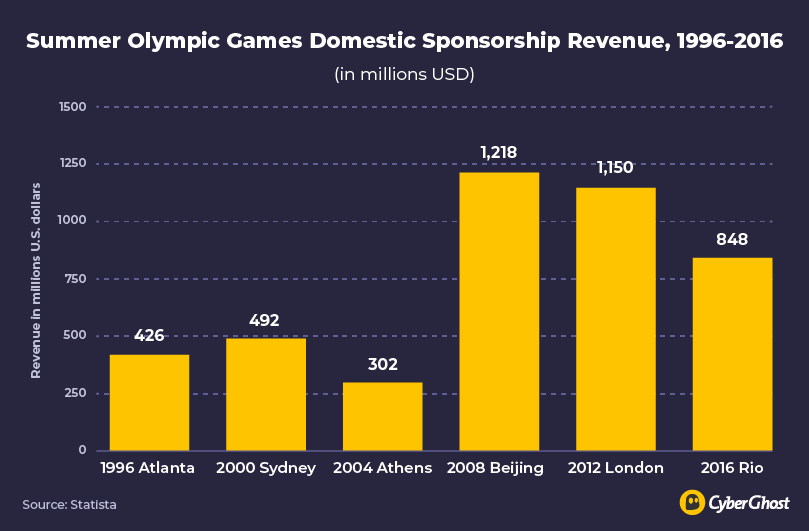
While there are more than a dozen TOP sponsors, around 70 additional businesses pay the IOC across the remaining three tiers of sponsorship.
Gold sponsors, official sponsors, and domestic sponsors make up the next three categories of sponsorship – each one less costly than the last. Domestic sponsorship features sponsors from the host nation – another important source of revenue for the host nation’s Organizing Committee and the IOC.
The host nation’s OCOG (Organising Committee for the Olympic Games) currently takes home around $2 billion per four-yearly sponsorship cycle, though, this could rise as sponsorship costs swell.
The IOC Is A Non-Profit
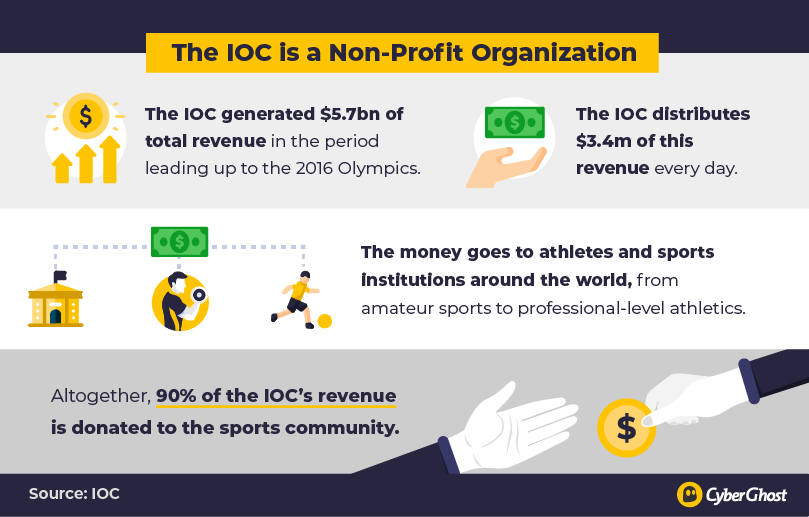
The IOC is a non-profit organization. That means almost every piece of advertising or broadcasting revenue gets redistributed to Olympic Organising Committees, sporting institutions, athletes, and grassroots coaching.
10% of total revenue is reinvested in the IOC. This money is used to develop sport and operations of the International Olympic Committee.
The IOC’s revenue distribution clearly works: IOC scholarship students won 13 medals at the 2018 PyeongChang Olympics.
Inspiring Future Athletes
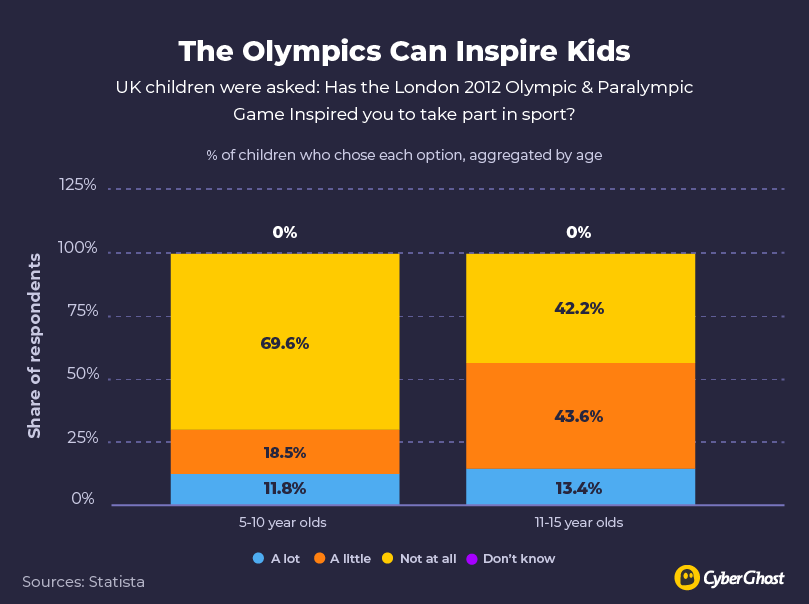
The Olympics inspire the next generation of athletes.
While the IOC invests in grassroots sports, kids watching the Olympics can be inspired by the unbelievable feats of achievement seen at the Olympic Games.
More than 50% of 11-15 years olds surveyed in the UK felt inspired by the London 2012 Olympics – a year that forged national icons such as Jessica Ennis and Mo Farah.
The stats show that the Olympics is crucial for the younger audience. The Games keep kids active and help create the next generation of potential athletes.
Progress and the Paralympics
Significant progress has been made at the Summer and Winter Paralympics since Sir Ludwig Guttman’s first iteration of a Paralympics Games during Rome 1960. Here are some stats that show Paralympic progress.
Rise in Number of Paralympic Participants
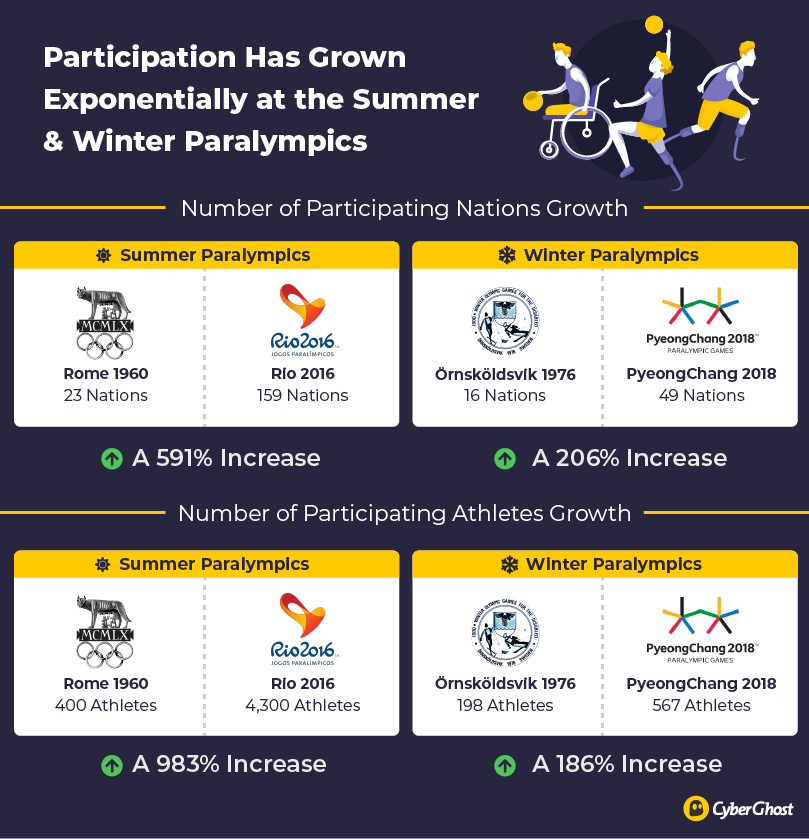
The Summer and Winter Paralympics have seen a huge growth in participation since their inception in 1960 and 1976 respectively.
The Summer Paralympics now has 591% more nations than its first event, and nearly 1000% more athletes.
The Winter Paralympics has enjoyed a 200% increase in participating nations and a 186% increase in athlete participation.
The stats point to tangible progress among the Paralympics community and disability sports as a whole.
More nations have joined the Paralympics as countries adopt a greater understanding of physical, mental, and sensorial disabilities. With greater opportunities to play disability sports and a larger number of Paralympic events, more athletes join the Games every time they are held.
Significant Audience Growth
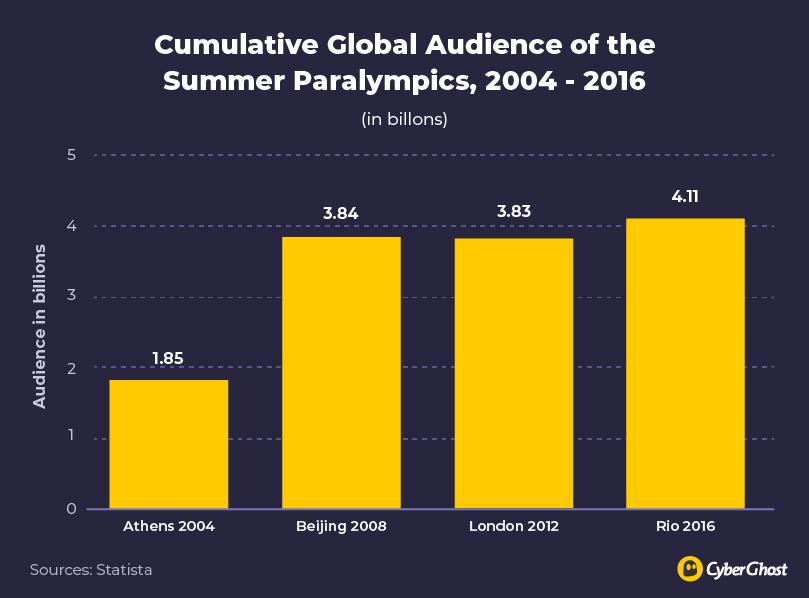
The Paralympics is attracting record audiences in recent years, signaling a growing interest and appreciation for disability sports.
Athens in 2004 reached a total of 1.85 billion people. The Rio 2016 Paralympics, on the other hand, reached a staggering 4.11 billion people.
That makes Rio 2016 the most popular Paralympics in history. It also puts the event on par with several Olympic events. 4.1 billion viewers is not far behind the Beijing Olympics’ record total viewership of 4.4 billion.
In fact, some Rio 2016 Paralympic events attracted bigger crowds than the Olympics. The Rio Paralympics track and field venue, the Olympic Stadium, sold 46,000 tickets on a single day. 170,000 people attended Paralympic events at the Olympic Park on Saturday 10th September 2016.
Rio overtook Beijing as the second most-attended Paralympics, while it tops the list for total audience reach.
Growing Number of Paralympic Sports
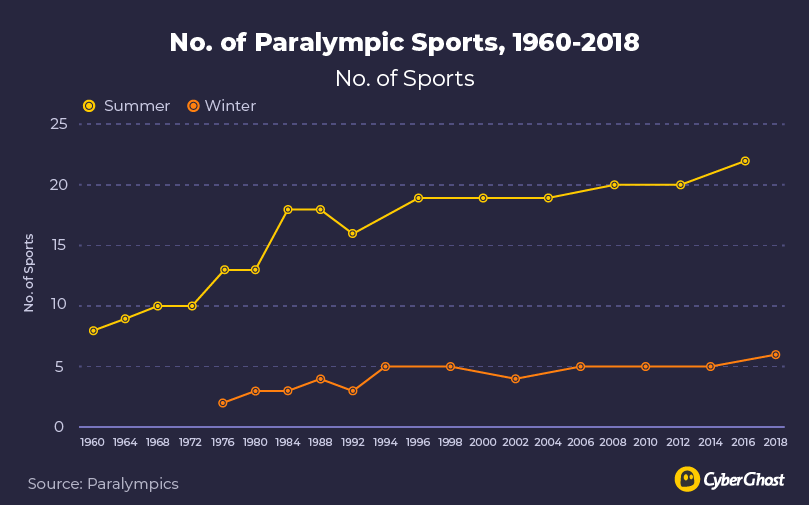
New Paralympic events are being created and added to the calendar as the profile of disability sports continually grows.
In many cases, new disability sports do not resemble their Olympic equivalent. Wheelchair rugby, for example, uses a different ball to its Olympic equivalent and takes place on a hard court.
The development across several sports also means Paralympic athletes are continually pushing the boundaries of what’s possible. The Seoul 1988 Paralympics produced 971 World Records and 156 Paralympic Records.
Top Paralympic Sports
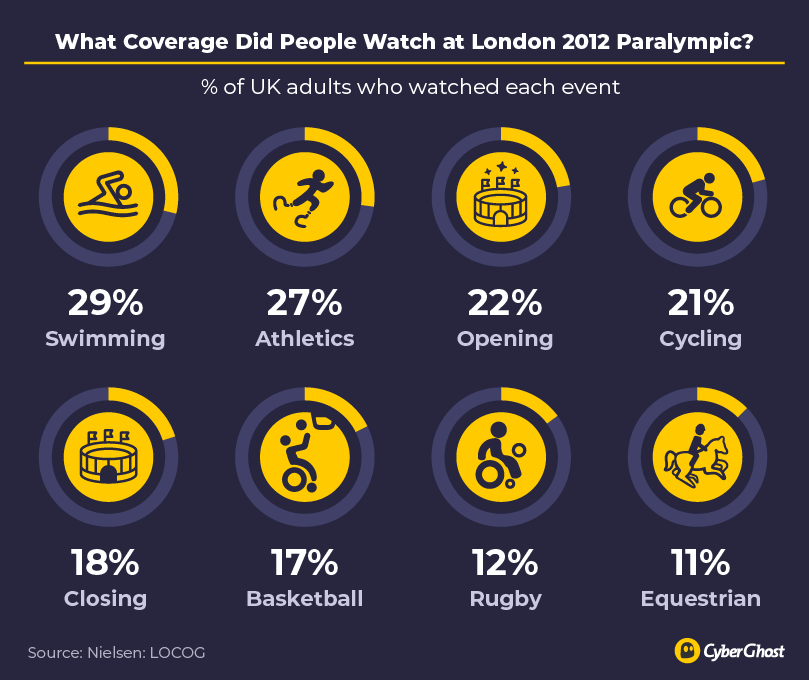
Top Paralympic sports include swimming, athletics, cycling, wheelchair basketball, and wheelchair rugby.
Millions of viewers also tune in to watch the opening and closing ceremonies of Paralympic events.
Paralympic Sponsorship
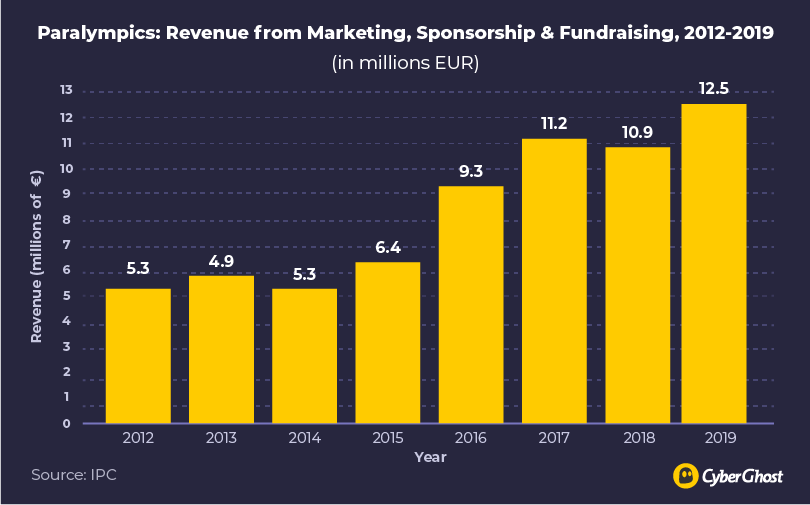
The International Paralympic Committee (IPC), essentially the corresponding Paralympic committee to the IOC, has seen huge increases in marketing, broadcasting, and sponsorship revenue over the last 8 years.
This is a key effect of the growing public interest in the Summer and Winter Paralympic Games.
Sponsorship revenue is now combined between the IOC and the IPC until 2032. Before this change, however, the Paralympics did attract interest from big brands. 5 out of 13 TOP sponsors in 2018 supported the Paralympic Games as well as the Olympic Games.
A Growing Budget
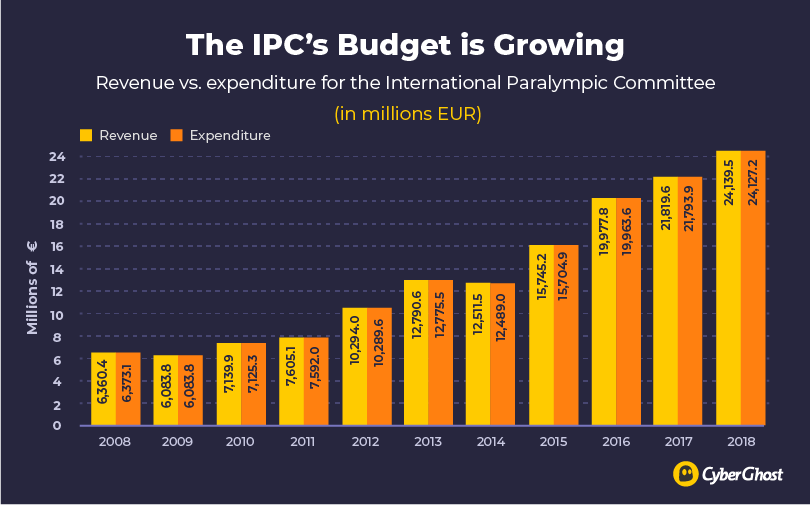
The IPC’s budget has also grown dramatically as interest and sponsorship revenue has increased. Since 2008, the IPC has quadrupled its revenue, rising from €6.3 billion to €24.1 billion in 2018.
Of course, like the IOC, the IPC is a non-profit organization. That means every penny of revenue is reinvested in disability athletes, facilities, and grassroots sports. As the IPC continues to grow, exposure and funding for disability sports will continue to grow with it.
The Paralympics is a Driver for Change
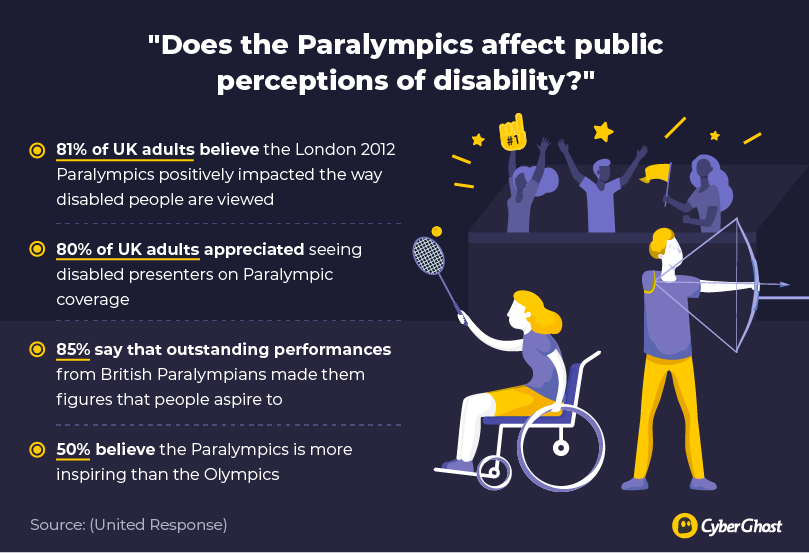
German-born British neurologist, Sir Ludwig Guttman, founded the Paralympic movement in 1960 following the success of the Stoke Mandeville Games 12 years prior. He would’ve turned 122 on July 3rd, 2021, should he still be alive. Yet, Guttman’s legacy lives on to this day.
uge progress has been made in the public perception and representation of not only disabled athletes, but the disabled community more generally. In this regard, the Paralympic Games are a driver for change – and London 2012 is often considered a turning point for disability representation. “The greatest Paralympics of all time,” as many people have called it.
This progress is more visible now than ever.
Olympics for Human Rights
The Olympics was not always the beacon of inclusion that it is today. It was originally formed as an event of “manly virtues,” while racial tensions and racist ideologies often underpinned narratives in earlier iterations of the Games. Watching the Olympics break free from old-fashioned beliefs has become significant in a wider fight for equal rights.
Recent changes to the Olympic oath highlight the games’ status as a global ambassador for civil rights. Two important words have been added to the oath’s first line: “inclusion” and “equality.”
Growth in Women Participants at the Summer Games
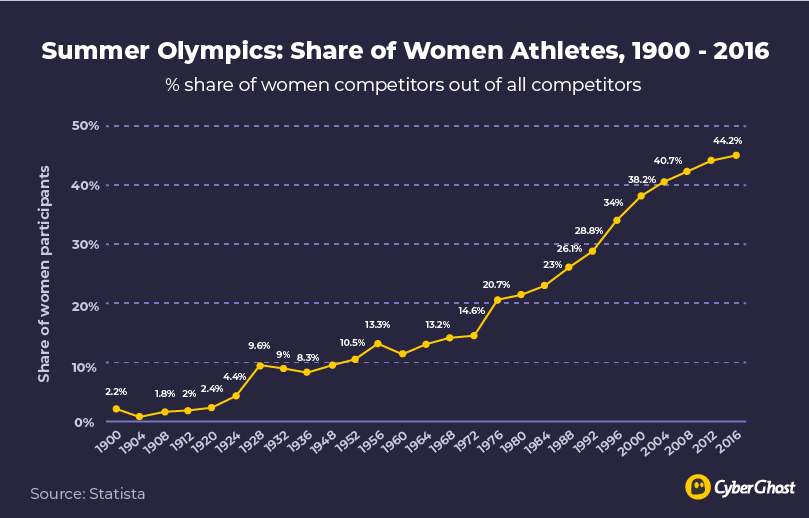
The Olympics was created as a celebration of male achievement, however, women were already allowed to compete by the second modern Olympic Games.
Just 2% of participants were women in 1900. The percentage of women has grown continuously over the last century or so, with women participants reaching a record 44% of total participants at the Rio 2016 games.
The Olympics is still trying to push boundaries for inclusion. Tokyo looks set to host the highest percentage share of women athletes to date. 49% of joining athletes will be women at Tokyo 2020.
The biggest change in the number of women athletes occurred following 1992, with around 700 more women athletes joining in 1996.
Saudi Arabia sent its first woman athlete to the London 2012 games. 2012 also marked the first Olympics in which every participating nation sent at least one woman athlete.
Growth in Women Participants at Winter Games
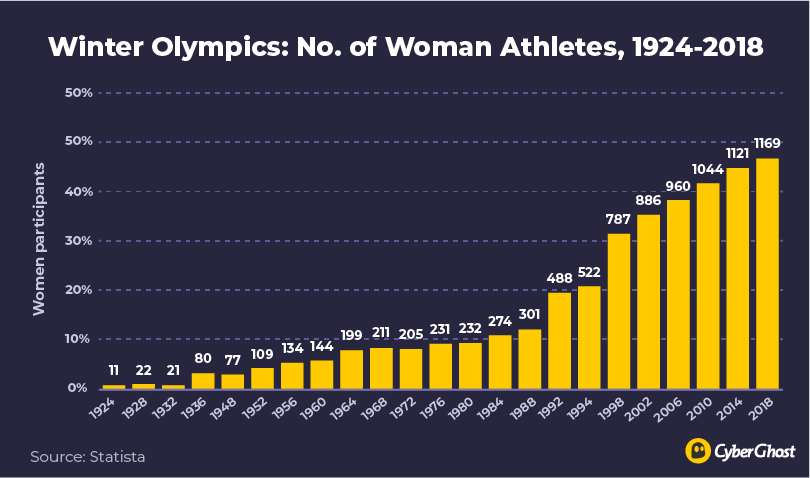
The Winter Olympics has seen major growth in women participants, too. Just 11 women athletes turned up for the 1924 Winter Games. In 2018, 1169 women athletes attended the Winter Olympics. That’s a 10,500% increase.
The 1998 Winter Olympics had 265 additional women athletes compared to the Games before, the biggest increase across two separate Winter Olympic events.
First Women’s Sports
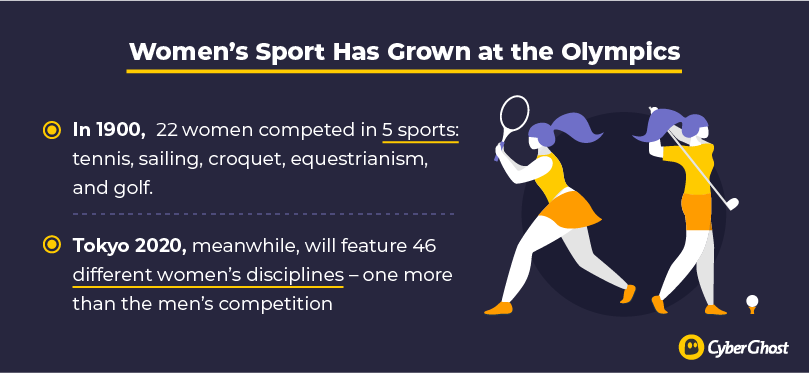
Tokyo 2020 will have 46 women’s disciplines, which is one more than the men’s competition.
This includes sports like weightlifting, wrestling, and shooting. These events have historically resisted women participants, reserved as a display of “manly virtues” in the eyes of the IOC and Pierre de Coubertin. Their inclusion now signals progress at the IOC and in society as a whole.
In 1900, women competed in just 5 sports: Tennis, sailing, croquet, equestrianism, and golf.
These sports were considered to be “ladylike,” so organizers were fine with women taking part. Though, women were not allowed to compete in a long list of other athletic events.
Fast-forward to 2021, and women are competing in more sports disciplines than men.
LGBTQ+ Athletes at the Olympics
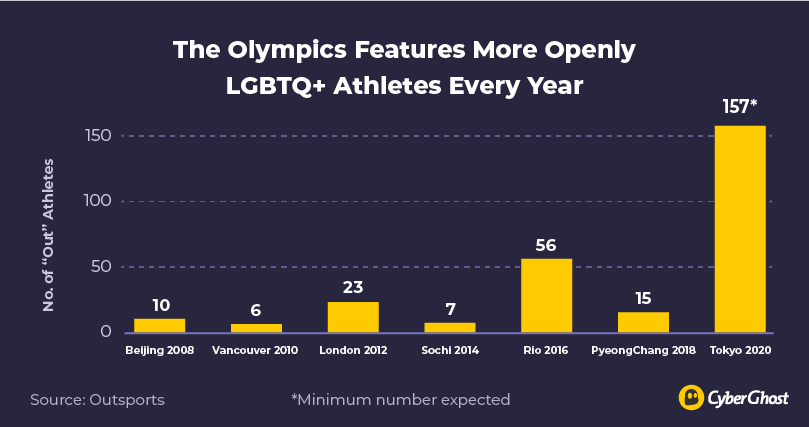
The number of openly “out” athletes is increasing every year. LGBTQ+ athletes are feeling more comfortable expressing their gender identity, though there is still work to be done.
Rio 2016 marked the most significant number of openly LGBTQ+ athletes to date. There were a total of 56 “out” athletes from 11,238. That’s over five times more out athletes than Beijing, eight years earlier.
Though we won’t know true figures until the Games begin, at least 157 openly LGBTQ+ athletes are expected to attend Tokyo 2020, according to Outsports. That’s a huge jump from Rio’s 2016 total of 56.
An openly gay couple, Edward Gal and Hans Peter Minderhoud, will even compete in the equestrian together.That being said, work needs to continue to make sure athletes feel comfortable coming out. There are likely many more athletes who are not yet ready to openly disclose their gender identity.
Tokyo for Trans Athletes

Tokyo 2020 will likely become the first Olympic Games to feature an openly transgender athlete, in what could become a watershed Olympic Games for the LGBTQ+ community.
It’s worth noting that the IOC has allowed transgender athletes to compete at the Olympic Games since 2004. Athletes that have transitioned from female to male are allowed to compete without restriction, whereas athletes that have transitioned from male to female must pass a minimum testosterone test for a full year prior to the Olympic Games.
Laurel meets all of the minimum testosterone levels set by the IOC. She transitioned in 2012 and competed in international weightlifting for the first time in 2017.
This means she’s cleared to compete and Laurel’s inclusion is a big win for the Trans community.
Black History Makers at the Olympics
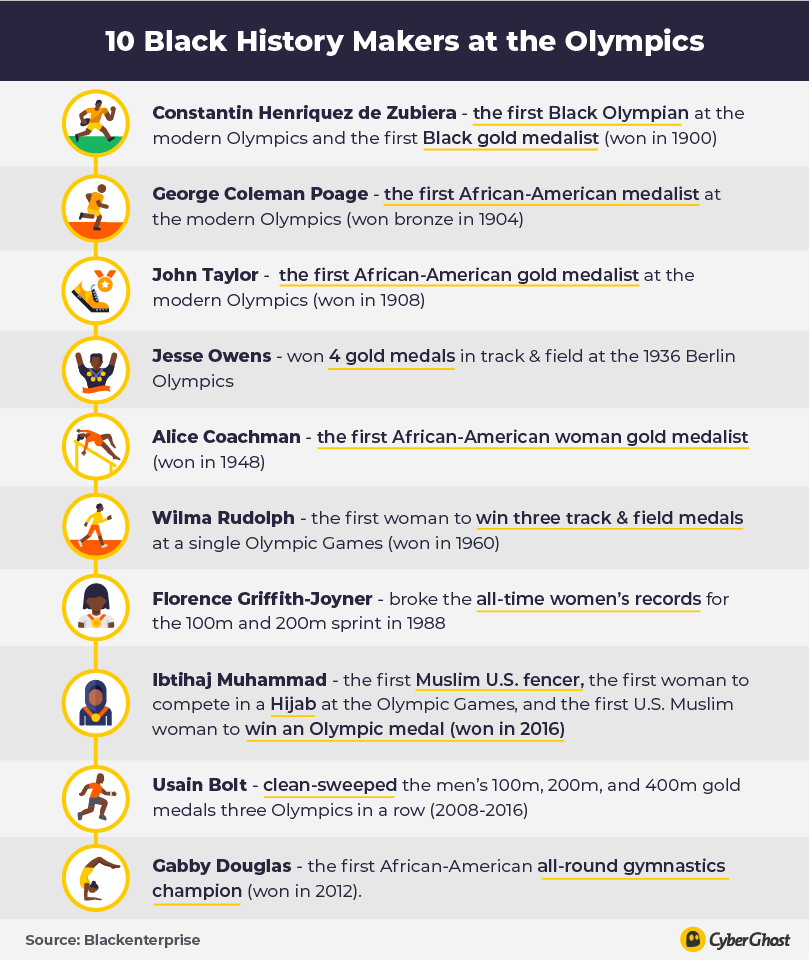
Racial politics have been tied into the Olympic Games ever since their beginnings.
The “anthropology days” sideshow of the St. Louis 1904 Olympics is one such example. U.S. scientists conducted “sporting experiments” on ethnic minorities to test their racist theorem: “‘Primitive’ civilizations are natural athletes.” Such a preposterous theory was quickly disproved and the event turned into nothing short of a total farce.
It’s within this context that Black achievement at the Olympics has been so important, and so impactful. Take Jesse Owens. The U.S. track and field star won 4 Olympic gold medals in the 1936 Berlin Olympics – an event conceived as a marketing tool for the Nazi regime. Jesse Owens disproved the Nazi’s “white supremacist” ideologies as people from around the world watched on.
Some Sports Are Still Catching Up
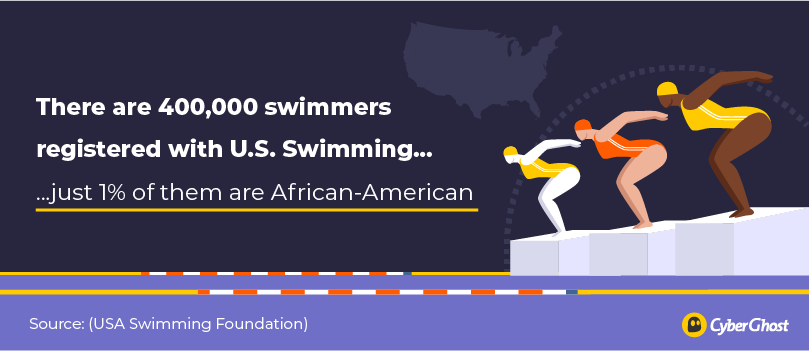
Some Olympic sports must still become more inclusive. This is particularly true for many “equipment” sports or (traditionally) white middle-class sports – ethnic minorities do not have the same socio-economic access and, thus, do not get the same Olympic representation.
Equestrianism, skiing, rowing – these are just a small sample of the sports that predominantly feature white athletes.
Swimming is another such sport. Swimmers need access to multi-million-dollar facilities and coaching to train – funding that ethnic minorities in poor neighborhoods do not usually receive.
Recent evidence suggests the swimming community craves greater inclusion. FINA – the International Swimming Federation, recognized by the IOC – recently rejected the use of swim caps designed specifically for African hair, stating that the caps did not follow “the natural form of the head.” However, FINA is now reviewing its decision following widespread backlash.
Controversy at the Olympics
Controversial issues often take center stage when the Olympic games come round the corner.
Environmental groups critique every facet of the event’s preparation, the host nation’s human rights record is analyzed extensively, and there is always the threat of other newsworthy incidents such as scandals and hacks.
Tokyo 2020 has not been able to dodge controversy. Officials and directors have been forced to resign following sexist and derogatory remarks – most recently, one of the composers of the opening ceremony stepped down after admitting to having bullied previous classmates, some of whom had disabilities.
Opposing Teams: Olympics vs Sustainability
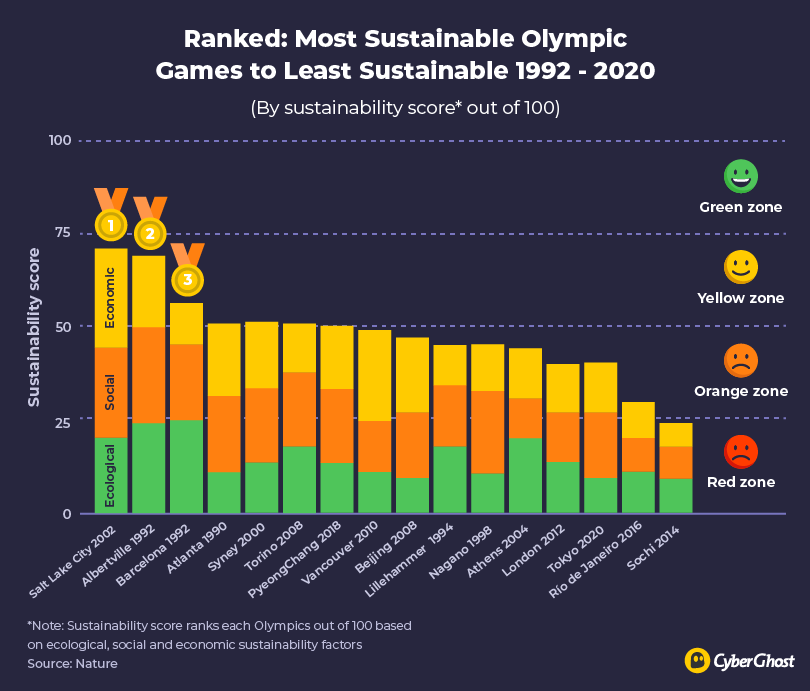
In a Nature study, each Olympics’ sustainability is ranked out of 100 based on ecological, social, and economic factors.
Ecological factors include new construction, visitor footprint, and event size. Social factors include public approval, safety, and rule of law. Economic factors include budget balance, financial exposure, and long-term viability. So, what progress in sustainability is being made at the Olympics? Not much, judging by recent research…
The Olympics claims to be a leading light of sustainability, yet, recent games have been the least sustainable in decades. Why is that? The economic spending involved in recent games is one issue. Tokyo could end up costing upwards of $30bn and is already $16bn over its original budget. That’s not sustainable at all.
In Tokyo’s case, public approval is also lacking as the country grapples with the COVID-19 pandemic. People are often displaced to build Olympic venues, too. Meanwhile, environmental groups have criticized the ecological credentials of Tokyo 2020. All of this in an Olympics where beds are made of cardboard, podiums use recycled plastic, and medals are constructed from recycled metals.
The construction of multiple large venues is a troublesome ecological issue for any Olympic Games. Tokyo’s use of plywood, in particular, is cited as a problem, with much of it allegedly sourced from rainforests, according to the Rainforest Action Network. Japan’s seafood industry is questionable as well – Japanese suppliers are not required to carry through with sustainability proposals to supply the Tokyo 2020 Games.
On the other side of the coin is Salt Lake City – the most sustainable Olympics. A large reason for Salt Lake City’s sustainability success is its relatively low cost. The 2002 Olympics cost just $2.5 billion.
Olympics-Driven People Displacement
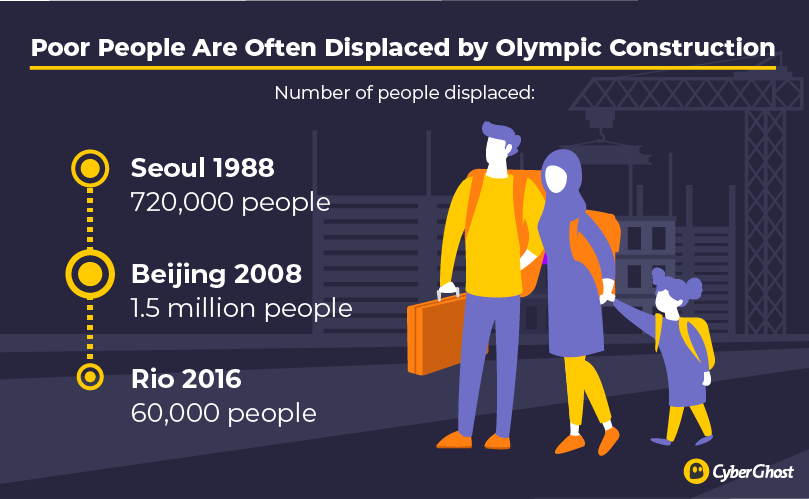
Host cities tend to embark on urban renewal projects, which may force people out of their homes to make way for shiny new venues. Invariably, poor people often suffer when Olympic events come to town. For this reason, the Games have been seen to promote attempts to gentrify certain communities.
Seoul started this trend in 1988 when the military moved nearly three-quarters of a million people out of their homes. Two more Olympics stick long in the memory for the same reason. Rio 2016 displaced 60,000 people from neighboring favelas. Much of Rio’s budget was even spent on fortifying a barrier between the Maré favelas and the nearby “Red Line” access road to the airport.
Meanwhile, China displaced 1.5 million people for its 2008 Olympics – a record for any Olympic Games.
That’s not to say the Olympic Games can’t be beneficial to local communities. Conversely, the Olympic Games bring new infrastructures, such as roads, transport links, and improved housing.
Affordable housing was included in London 2012’s regeneration of the Olympic Village, for example, while Brazil heavily invested in its metro system for the 2016 Games. Beijing spent over half of its $40 billion budget on rail links, roads, and airports too. This is in addition to all of the benefits that new sporting facilities and venues provide.
Big Olympic Scandals

Three institutional scandals stick in the memory from recent Olympics: The IOC is by no means squeaky clean, and neither are some of the nations that compete.
After winning the bid to host the Olympics in 2002, it soon came to light that IOC officials – those involved in the IOC’s decision-making process – had been gifted special “sweeteners” from Salt Lake City.
This included tuition fees, direct payments, and land purchases on behalf of fraudulent IOC members and their families.
Even in 2021, there remains controversy over Olympic bidding. The IOC has all but confirmed Brisbane as the Olympic host for 2032 after an offer the IOC found “somehow irresistible, ” in the words of the IOC’s president.
This is contentious, given we are 11 years away from the 2032 Olympic Games. Normally, the IOC schedules site selection just 7 years before an Olympic Games. Nonetheless, the issue will be debated at Tokyo 2020.
The 2002 Games were not short of controversy themselves. After a tense final between Russia and Canada in the figure skating pairs, French judge Marie-Reine Le Gougne claimed she had been pressured into scoring Russia as the winner by her boss. The event was part of a vote-trading scandal that ultimately led to reform in the games.
The most recent Olympic scandal on this list occurred before the Rio Olympics in 2016.
Following reports of a mass-doping program in Russia, the IOC tested every Russian athlete set to compete. Ultimately, 116 athletes were banned, and Russia was forbidden from competing for several years.
The Biggest Hack in Olympic History
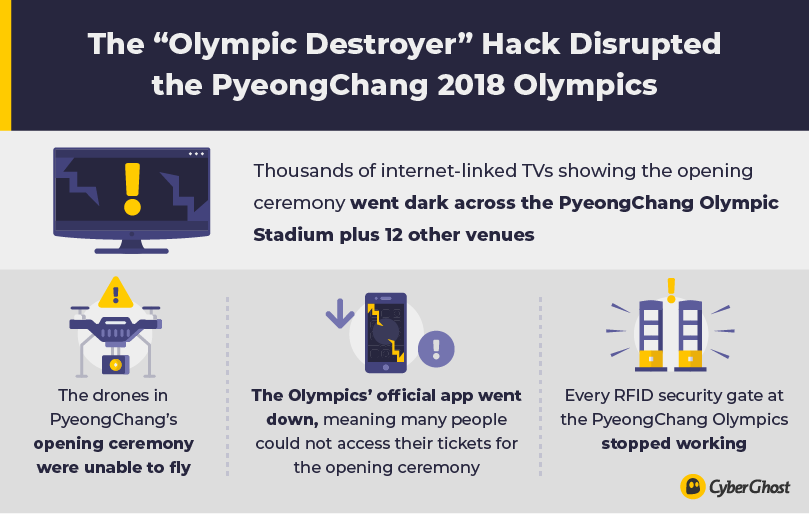
The Olympic Destroyer hack was one of the biggest cyberattacks in Olympic history. Malware shut down over 300 systems in PyeongChang’s data centers, which affected a host of other Wi-Fi services for the first 12 hours of the games.
The attacks started during PyeongChang’s opening ceremony, crippling the event’s entire system.
The event staff’s domain controllers were initially paralyzed. Security experts had to take PyeongChang’s system offline to identify and eradicate the malicious files on their system.
Cybersecurity experts eventually discovered a file called “winlogon.exe” to be the culprit, with state-sponsored Russian hackers suspected as the source.
This isn’t the first time an Olympic Games has been cyberattacked. London 2012 was hit with numerous intrusion attempts and at Rio 2016, athletes’ personal data was leaked.
Russia is thought to be seeking revenge for its competition ban and hackers could target Tokyo 2020. The UK’s National Cyber Security Center recently revealed that Russia was already planning cyber-attacks before the Tokyo Olympic Games were postponed in 2020.
Following PyeongChang 2018 and recent reports of Russian activity, Tokyo officials anxiously await another hacking attempt in 2021.
Are you concerned about your cybersecurity too? You’ll find a variety of safety and security resources here on the CyberGhost Privacy Hub.
The Bottom Line – Enjoy the Games
So here’s our long list of 60+ Olympics and Paralympics statistics. We’ve covered every base to keep you in the know for Tokyo 2020.
At its best, the Olympics is a truly legendary festival of competition, dedication, and human achievement. However, the Olympics’ motto of “Faster, Higher, Stronger” can also be symbolic of society’s flaws.
The Olympics attract such global interest, and it’s crucial that the competition continues to champion equal opportunity and integrity. With this in mind, Tokyo 2020 might be the glimmer of hope everyone needs in 2021.
All in all, the Olympics is a spine-tingling competition and we can’t wait till Tokyo 2020 gets underway. Armed with your newfound Olympic knowledge, hopefully, you can’t wait either.



Leave a comment